Metal organic frameworks for gas storage
Alezi , et al. December 22, 2
U.S. patent number 10,870,101 [Application Number 16/402,597] was granted by the patent office on 2020-12-22 for metal organic frameworks for gas storage. This patent grant is currently assigned to King Abdullah University of Science and Technology. The grantee listed for this patent is King Abdullah University of Science and Technology. Invention is credited to Dalal Alezi, Youssef Belmabkhout, Mohamed Eddaoudi.
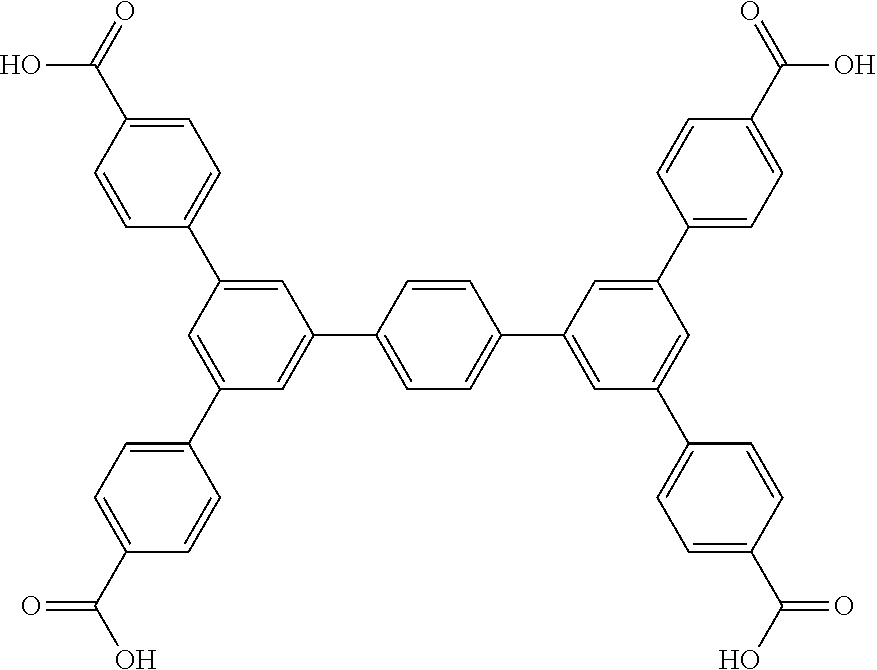


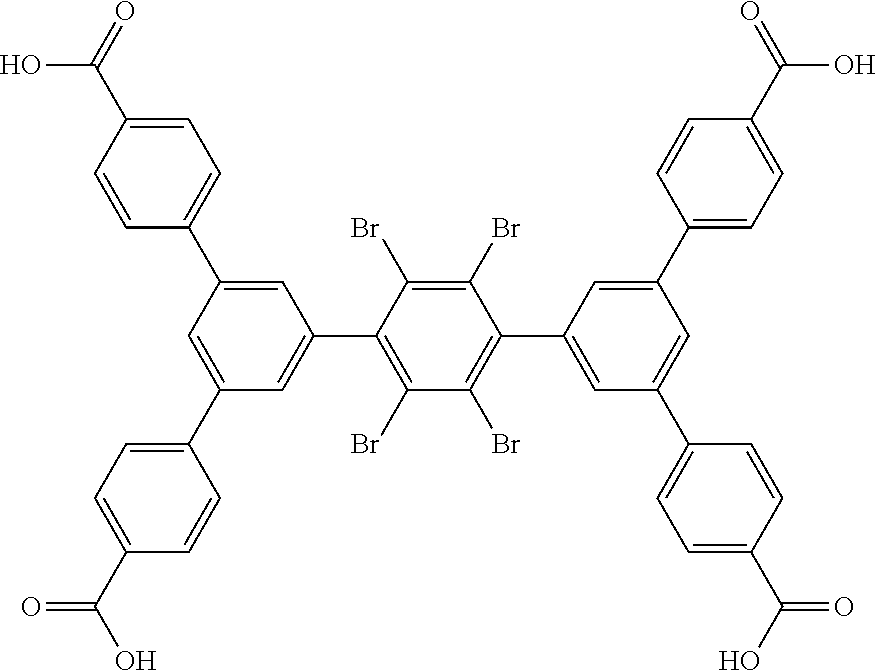
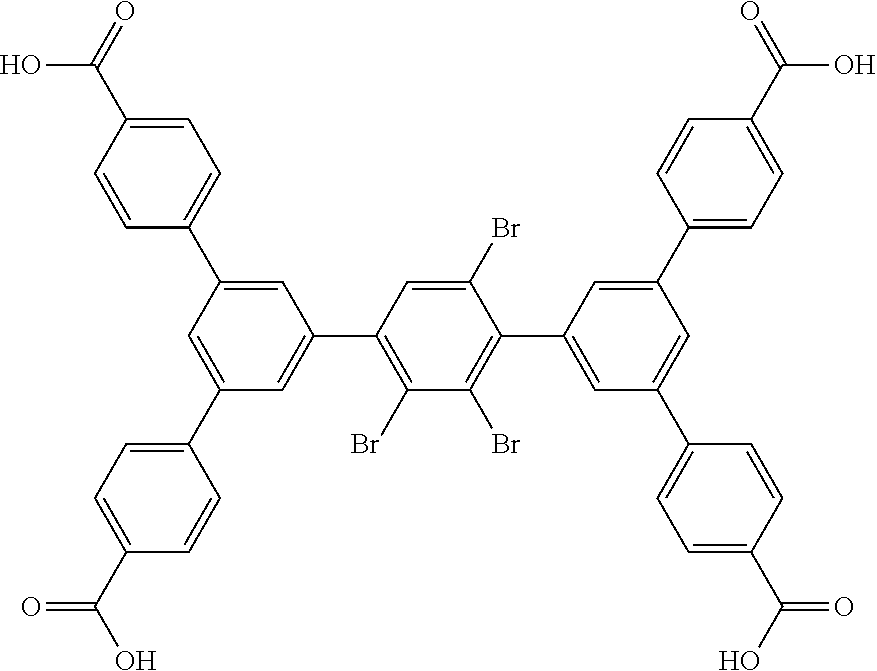



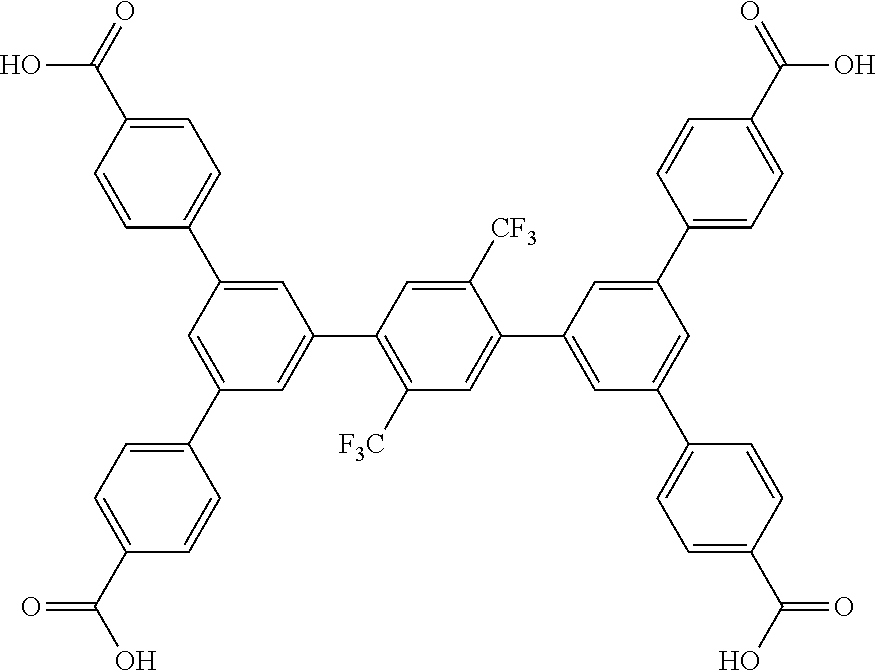
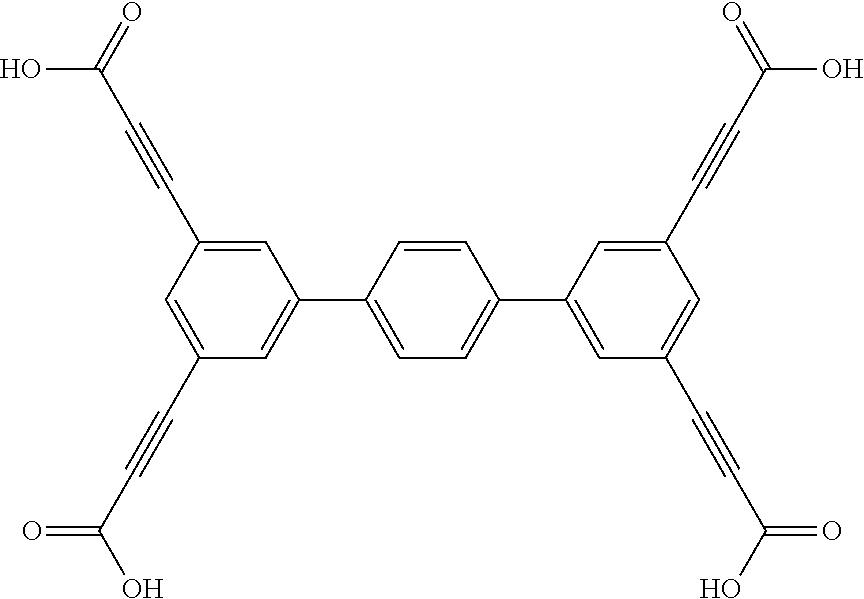


View All Diagrams
| United States Patent | 10,870,101 |
| Alezi , et al. | December 22, 2020 |
Metal organic frameworks for gas storage
Abstract
Embodiments of the present disclosure describe methods of removing one or more compounds from a fluid comprising contacting a metal-organic framework (MOF) composition having a square-octahedral topology with a fluid containing one or more of CH.sub.4 and O.sub.2, sorbing one or more of CH.sub.4 and O.sub.2 with the MOF composition, and storing one or more of the CH.sub.4 and O.sub.2 with the MOF composition.
| Inventors: | Alezi; Dalal (Thuwal, SA), Belmabkhout; Youssef (Thuwal, SA), Eddaoudi; Mohamed (Thuwal, SA) | ||||||||||
|---|---|---|---|---|---|---|---|---|---|---|---|
| Applicant: |
|
||||||||||
| Assignee: | King Abdullah University of Science
and Technology (Thuwal, SA) |
||||||||||
| Family ID: | 1000005255800 | ||||||||||
| Appl. No.: | 16/402,597 | ||||||||||
| Filed: | May 3, 2019 |
Prior Publication Data
| Document Identifier | Publication Date | |
|---|---|---|
| US 20190255511 A1 | Aug 22, 2019 | |
Related U.S. Patent Documents
| Application Number | Filing Date | Patent Number | Issue Date | ||
|---|---|---|---|---|---|
| 15532839 | 10322402 | ||||
| PCT/IB2015/059383 | Dec 4, 2015 | ||||
| 62087517 | Dec 4, 2014 | ||||
| Current U.S. Class: | 1/1 |
| Current CPC Class: | B01D 53/0476 (20130101); B01D 53/02 (20130101); B01J 20/226 (20130101); B01D 53/047 (20130101); B01D 2259/4525 (20130101); F17C 11/007 (20130101); B01D 2258/05 (20130101); B01D 2257/7025 (20130101); B01D 2257/104 (20130101); Y02C 20/20 (20130101); B01D 2253/204 (20130101) |
| Current International Class: | B01D 53/46 (20060101); B01D 53/02 (20060101); B01D 53/14 (20060101); B01D 53/72 (20060101); B01D 53/80 (20060101); B01D 53/81 (20060101); B01D 53/96 (20060101); C10L 3/06 (20060101); C10L 3/10 (20060101); B01J 31/16 (20060101); B01J 20/22 (20060101); B01D 53/047 (20060101); F17C 11/00 (20060101) |
References Cited [Referenced By]
U.S. Patent Documents
| 9102691 | August 2015 | Zhou et al. |
| 9724668 | August 2017 | Zhou et al. |
| 10322402 | June 2019 | Alezi |
| 2016033086 | Mar 2016 | WO | |||
Other References
|
"International Search Report and Written Opinion", International Application No. PCT/US2015/046756, dated Nov. 2, 2015, 10 pages. cited by applicant . Babarao, et al., "Molecular simulations for adsorptive separation of CO2/CH4 Mixture in metal-exposed, catenated, and charged metal-Organic Frameworks", Langmuir Article, 2009, 5239-5247. cited by applicant . Belmabkhout, et al., "Simultaneous Adsorption of H2S and CO2 on Triamine-Grafted Pore-Expanded Mesoporous MCM-41 Silica", Energy Fuels 2011, 25, 1310-1315. cited by applicant . Christophe, et al., "Synthesis, Single-Crystal X-ray Microdiftraction, and NMR Characterizations of the Giant Pore Metal-Organic Framework Aluminum Trimesate MIL-100", Chemistry of Materials Communication, American Chemical Society, 2009, 5695-5697. cited by applicant . Felipe, et al., "High Methane Storage Capacity in Aluminum Metal-Organic Frameworks", Journal of the American Chemical Society, 2014, 5271-5274. cited by applicant . Hiroyasu, et al., "Ultrahigh Porosity in Metal-Organic Frameworks", Science, vol. 329, Jul. 23, 2010, 424-429. cited by applicant . Liu, et al., "Assembly of metal-organic frameworks (MOFs) based on indium-timer building blocks: A porous MOF with soc Topology and High hydrogen storage", Angew.Chem. Int., Ed., 2007, 3278-3283. cited by applicant . Moellmer, et al., "Insights on Adsorption Characterization of Metal-Organic Frameworks: A Benchmark Study on the Novel soc-MOF", Microporus and Mesoporous Materials, Elsevier Science Publishing, New York, US, 345-353, Apr. 15, 2010. cited by applicant . Mohamed, et al., "Zeolite-like metal-organic frameworks (ZMOFs): design, synthesis, and properties", Chem Soc Rev, Royal Society of Chemistry, 2015, 228-249. cited by applicant . Morris, et al., "Gas Storage in Nanoporous Materials", Gas Storage Materials, Angewandte Chemie Int. Ed., 2008, 4966-4981. cited by applicant . Mowat, et al., "Synthesis, characterisation and adsorption properties of microporous scandium carboxylates with ridig and flexible frameworks", Microporous and Mesoporous Materials, 2011, 322-333. cited by applicant . Mueller, et al., "Metal-organic frameworks--prospective industrial applications", Journal of Materials Chemistry, 2006, 626-636. cited by applicant . Pang, et al., "Highly monodisper M'-based soc-MOFs(M=In and Ga) with cubic and truncated cubic morphologies", Journal of the American Chemical Society, 2012, 13176-13179. cited by applicant . Peng, et al., "Computational screening of porous carbons, zeolites, and metal organic frameworks for desulfurization and decarburization of biogas, natural gas, and flue gas", AIChE Journal, Aug. 2013, 2928-2942. cited by applicant . Thomas, et al., "High valence 3p and transition metal based MOFs", Chem Soc Rev, Royal Society of Chemistry, 2014, 6097-6115. cited by applicant . Vincent, et al., "A Supermolecular building approach for the design and construction of metal-organic frameworks", Chem Soc Rev, Royal Society of Chemistry, 2014, 6141-6172. cited by applicant . Yabing, et al., "Methane storage in metal-organic frameworks", Chem Soc Rev, Royal Society of Chemistry, 2014, 5657-5678. cited by applicant . Yu, et al., "High Pressure Excess Isotherms for Adsorption of Oxygen and Nitrogen in Zeolites", Langmuir, 2011, 10648-10656. cited by applicant . Allen, "The Cambridge Structural Database: A Quarter of a Million Crystal Structures and Rising", Acta Crystallographica Section B Structural Science, vol. 58, 2002, pp. 380-388. cited by applicant . Bae, "Carborane-Based Metal-Organic Frameworks as Highly Selective Sorbents for CO2 over Methane", Chemical Communications, 2008, pp. 4135-4137. cited by applicant . Barthelet, et al., "[VIII(H2O)]3O(O2CC6H4CO2)3-(Cl, 9H2O) (MIL-59):A Rare Example of Vanadocarboxylate With a Magnetically Frustrated Three-Dimensional Hybrid Framework", Chemical Communications, Jun. 11, 2002, pp. 1492-1493. cited by applicant . Bloch, et al., "Hydrocarbon Separations in a Metal-Organic Framework with Open Iron(II) Coordination Sites", , vol. 335, Mar. 30, 2012, 1606-1610. cited by applicant . Bourrelly, et al., "Different Adsorption Behaviors of Methane and Carbon Dioxide in the Isotypic Nanoporous Metal Terephthalates MIL-53 and MIL-47", Journal of the American Chemical Society, vol. 127, Sep. 13, 2005, pp. 13519-13521. cited by applicant . Brant, et al., "Single-Metal-Ion-Based Molecular Building Blocks (MBBs) Approach to the Design and Synthesis of Metal-Organic Assemblies", Journal of Molecular Structure, vol. 796, 2006, pp. 160-164. cited by applicant . Brown, et al., "Quantum Rotation of Hydrogen in Single-Wall Carbon Nanotubes", Chemical Physics Letters, vol. 329, 2000, pp. 311-316. cited by applicant . Cote, et al., "Porous, Crystalline, Covalent Organic Frameworks", Science, vol. 310, Nov. 18, 2005, pp. 1166-1170. cited by applicant . Dybtsev, et al., "Rigid and Flexible: A Highly Porous Metal-Organic Framework with Unusual Guest-Dependent Dynamic Behavior", Angewandte Chemie International Edition, vol. 43, 2004, pp. 5033-5036. cited by applicant . Eddaoudi, et al., "Geometric Requirements and Examples of Important Structures in the Assembly of Square Building Blocks", PNAS, vol. 99, No. 8, Apr. 16, 2002, pp. 4900-4904. cited by applicant . Eddaoudi, et al., "Modular Chemistry: Secondary Building Units as a Basis for the Design of Highly Porous and Robust Metal-Organic Carboxylate Frameworks", Accounts of Chemical Research,. vol. 34, No. 4, Feb. 17, 2001, pp. 319-330. cited by applicant . Eddaoudi, et al., "Systematic Design of Pore Size and Functionality in Isoreticular MOFs and Their Application in Methane Storage", Science, vol. 295, Jan. 18, 2002, 469-472. cited by applicant . Evans, et al., "Crystal Engineering of NLO Materials Based on Metal-Organic Coordination Networks", Accounts of Chemical Research, vol. 35, No. 7, Apr. 20, 2002, pp. 511-522. cited by applicant . Ferey, et al., "A Chromium Terephthalate-Based Solid with Unusually Large Pore Volumes and Surface Area", Science, vol. 309, Sep. 23, 2005, pp. 2040-2042. cited by applicant . Ferey, et al., "A Hybrid Solid with Giant Pores Prepared by a Combination of Targeted Chemistry, Simulation, and Powder Diffraction", Angewandte Chemie International Edition, vol. 43, 2004, pp. 6296-6301. cited by applicant . Ferey, et al., "Crystallized Frameworks with Giant Pores: Are There Limits to the Possible?", Accounts of Chemical Research, vol. 38, No. 4, Jan. 19, 2005, pp. 217-225. cited by applicant . Ferey, et al., "Hydrogen Adsorption in the Nanoporous Metal-Benzenedicarboxylate M(OH)(O2C--C6H4--CO2) (M=Al3+, Cr3+), MIL-53", Chemical Communications, vol. 24, Nov. 4, 2003, pp. 2976-2977. cited by applicant . Forster, et al., "Hydrogen Adsorption in Nanoporous Nickel(II) Phosphates", Journal of the American Chemical Society, vol. 125, Jan. 10, 2003, pp. 1309-1312. cited by applicant . Fujita, et al., "Coordination Assemblies from a Pd(II)-Cornered Square Complex", Accounts of Chemical Research, vol. 38, No. 4, Feb. 15, 2005, pp. 371-380. cited by applicant . Hamon, et al., "Comparative Study of Hydrogen Sulfide Adsorption in the MIL-53(Al, Cr, Fe), MIL-47(V), MIL-100(Cr), and MIL-101(Cr) Metal-Organic Frameworks at Room Temperature", Journal of the American Chemical Society, vol. 131, 2009, pp. 8775-8777. cited by applicant . Hirsch, et al., "Spherical Aromaticity of Inorganic Cage Molecules", Angewandte Chemie International Edition, vol. 40, No. 15, 2001, pp. 2834-2838. cited by applicant . Kahn, "Chemistry and Physics of Supramolecular Magnetic Materials", Accounts of Chemical Research, vol. 33, No. 10, Oct. 2000, pp. 647-657. cited by applicant . Kaye, et al., "Hydrogen Storage in the Dehydrated Prussian Blue Analogues M3[Co(CN)6]2 (M=Mn, Fe, Co, Ni, Cu, Zn)", Journal of the American Chemical Society, vol. 127, Apr. 15, 2005, pp. 6506-6507. cited by applicant . Kitagawa, et al., "Functional Porous Coordination Polymers", Angewandte Chemie International Edition, vol. 43, 2004, pp. 2334-2375. cited by applicant . Leclerc, et al., "Infrared Study of the Influence of Reducible Iron(III) Metal Sites on the Adsorption of CO, CO2, Jropane, Propene and Propyne in the Mesoporous Metal-Organic Framework MIL-100", Physical Chemistry Chemical Physics, vol. 13, 2011, pp. 11748-11756. cited by applicant . Lee, et al., "A Comparison of the H2 Sorption Capacities of Isostructural Metal-Organic Frameworks With and Without Accessible Metal Sites: [{Zn2(abtc)(dmf)2}3] and [{Cu2(abtc)(dmf)2}3] versus [{Cu2(abtc)}3]", Angewandte Chemie International Edition, vol. 47, 2008, pp. 7741-7745. cited by applicant . Lee, et al., "Achieving High Density of Adsorbed Hydrogen in Microporous Metal Organic Frameworks", Advanced Materials, vol. 17, 2005, pp. 2703-2706. cited by applicant . Lee, et al. "Gas Sorption Properties of Microporous Metal Organic Frameworks", Journal of Solid State Chemistry, vol. 178, 2005, pp. 2527-2532. cited by applicant . Li, et al., "Coordinatively Unsaturated Metal Centers in the Extended Porous Framework of Zn3(BDC)3.6CH3OH (BDC=1,4-Benzenedicarboxylate)", Journal of the American Chemical Society, vol. 120, No. 9, Feb. 20, 1998, pp. 2186-2187. cited by applicant . Li, et al., "Design and Synthesis of an Exceptionally Stable and Highly Porous Metal-Organic Framework", Nature, vol. 402, Nov. 18, 1999, pp. 276-279. cited by applicant . Li, et al., "Selective Gas Adsorption and Separation in Metal-Organic Frameworks", Chemical Society Reviews, vol. 38, 2009, pp. 1477-1504. cited by applicant . Liu, et al., "4-Connected Metal-Organic Assemblies Mediated via Heterochelation and Bridging of Single Metal Ions: Kagome Lattice and the M6L12 Octahedron", Journal of the American Chemical Society, vol. 127, Apr. 27, 2005, pp. 7266-7267. cited by applicant . Liu, et al., "Molecular Building Blocks Approach to the Assembly of Zeolite-Like Metal-Organic Frameworks (ZMOFs) With Extra-Large Cavities", Chemical Communications, Feb. 2, 2006, pp. 1488-1490. cited by applicant . Macgillivray, et al., "A Chiral Sphericalmolecular Assembly Held Together by 60 Hydrogen Bonds", Nature, vol. 389, Oct. 2, 1997, pp. 469-472. cited by applicant . Matsuda, et al., "Highly Controlled Acetylene Accommodation in a Metal-Organic Microporous Material", Nature, vol. 436, Jul. 14, 2005, pp. 238-241. cited by applicant . Mendes, et al., "Separation of Hexane Isomers on Rigid Porous Metal Carboxylate-Based Metal-Organic Frameworks", Adsorption Science & Technology, vol. 32, No. 6, 2014, pp. 475-488. cited by applicant . Moon, et al., "Redox-Active Porous Metal-Organic Framework Producing Silver Nanoparticles from Agl Ions at Room Temperature", Angewandte Chemie International Edition, vol. 44, 2005, pp. 1261-1265. cited by applicant . Moulton, et al., "Crystal Engineering of a Nanoscale Kagome Lattice", Angewandte Chemie, vol. 114, No. 15, 2002, pp. 2945-2948. cited by applicant . Moulton, et al., "From Molecules to Crystal Engineering: Supramolecular Isomerism and Polymorphism in Network Solids", Chemical Reviews, vol. 101, No. 6, May 12, 2001, pp. 1629-1658. cited by applicant . Nicol, et al., "Dynamics of Molecular Hydrogen Adsorbed in CoNa-A Zeolite", Journal of Physical Chemistry, vol. 92, 1988, pp. 7117-7121. cited by applicant . Noro, et al., "A New, Methane Adsorbent, Porous Coordination Polymer [{CuSiF6(4,4'-bipyridine)2}]", Angewandte Chemie International Edition, vol. 39, No. 12, 2000, pp. 2081-2084. cited by applicant . O'Keeffe, et al., "Frameworks for Extended Solids: Geometrical Design Principles", Journal of Solid State Chemistry, vol. 152, 2000, pp. 3-20. cited by applicant . Ren, et al., "Neutron Scattering Study of H2 Adsorption in Single-Walled Carbon Nanotubes", Applied Physics Letters, vol. 79, No. 22, Nov. 26, 2001, pp. 3684-3686. cited by applicant . Rosi, et al., "Hydrogen Storage in Microporous Metal-Organic Frameworks", Science, vol. 300, May 16, 2003, pp. 1127-1129. cited by applicant . Rowsell, et al., "Characterization of H2 Binding Sites in Prototypical Metal-Organic Frameworks by Inelastic Neutron Scattering", Journal of the American Chemical Society, vol. 127, 2005, pp. 14904-14910. cited by applicant . Safarik, et al., "Olefin/Paraffin Separations by Reactive Absorption: A Review", Industrial & Engineering Chemistry Research, vol. 37, 1998, pp. 2571-2581. cited by applicant . Seidel, et al., "High-Symmetry Coordination Cages via Self-Assembly", Accounts of Chemical Research, vol. 35, No. 11, Aug. 21, 2002, pp. 972-983. cited by applicant . Seo, et al., "A Homochiral Metal-Organic Porous Material for Enantioselective Separation and Catalysis", Nature, vol. 404, Apr. 27, 2000, pp. 982-986. cited by applicant . Silvera, "The Solid Molecular Hydrogens in the Condensed Phase: Fundamentals and Static Properties", Reviews of Modern Physics, vol. 52, No. 2, Part I, Apr. 1980, pp. 393-452. cited by applicant . Sudik, et al., "Metal-Organic Frameworks Based on Trigonal Prismatic Building Blocks and the New "acs" Topology", Inorganic Chemistry, vol. 44, No. 9, Mar. 31, 2005, pp. 2998-3000. cited by applicant . Volkringer, et al., "A New Indium Metal-Organic 3D Framework With 1,3,5-Benzenetricarboxylate, MIL-96 (In), Containing u3-Oxo-Centered Trinuclear Units and a Hexagonal 18-Ring Network", Materials Research Bulletin, vol. 41, 2006, pp. 948-954. cited by applicant . Wang, et al., "Design, Synthesis, and Photochemical Behavior of Poly(benzyl ester) Dendrimers with Azobenzene Groups throughout Their Architecture", Journal of Organic Chemistry, vol. 69, No. 26, Dec. 1, 2004, pp. 9073-9084. cited by applicant . Wu, et al., "A Homochiral Porous Metal-Organic Framework for Highly Enantioselective Heterogeneous Asymmetric Catalysis", Journal of the American Chemical Society, vol. 127, No. 25, Jun. 4, 2005, pp. 8940-8941. cited by applicant . Xiang, et al., "Rationally Tuned Micropores Within Enantiopure Metal-Organic Frameworks for Highly Selective Separation of Acetylene and Ethylene", Nature Communications, vol. 2, No. 204, Feb. 22, 2011, pp. 1-7. cited by applicant . Yaghi, et al., "Construction of a New Open-Framework Solid From 1,3,5-Cyclohexanetricarboxylate and Zinc(II) Building Blocks", Journal of the Chemical Society, Dalton Transactions, Jan. 1, 1997, pp. 2383-2384. cited by applicant . Yaghi, et al., "Reticular Synthesis and the Design of New Materials", Nature, vol. 423, Jun. 12, 2003, pp. 705-714. cited by applicant . Yaghi, et al., "Selective Guest Binding by Tailored Channels in a 3-D Porous Zinc(II)-Benzenetricarboxylate Network", Journal of the American Chemical Society, vol. 119, No. 12, 1997, pp. 2861-2868. cited by applicant . Yang, et al., "Zinc Phosphate with Gigantic Pores of 24 Tetrahedra", Journal of the American Chemical Society, vol. 121, Aug. 31, 1999, pp. 8389-8390. cited by applicant . Yoon, et al., "Controlled Reducibility of a Metal-Organic Framework with Coordinatively Unsaturated Sites for Preferential Gas Sorption", Angewandte Chemie International Edition, vol. 49, 2010, pp. 5949-5952. cited by applicant . Zhang, et al., "Microporous Metal-Organic Frameworks for Acetylene Storage and Separation", CrystEngComm, vol. 13, 2011, pp. 5983-5992. cited by applicant . Zhao, et al., "Hysteretic Adsorption and Desorption of Hydrogen by Nanoporous Metal-Organic Frameworks", Science, vol. 306, Nov. 5, 2004, pp. 1012-1015. cited by applicant. |
Primary Examiner: Berns; Daniel
Attorney, Agent or Firm: Billion & Armitage Schwartz; Gregory S.
Claims
What is claimed is:
1. A method of removing one or more compounds from a fluid, comprising: contacting a metal-organic framework (MOF) composition having a square-octahedral topology with a fluid containing one or more of CH.sub.4 and O.sub.2, wherein the MOF composition includes an organic ligand and a metal selected from aluminum, gallium, iron, scandium, titanium, chromium, and vanadium; sorbing one or more of CH.sub.4 and O.sub.2 with the MOF composition; and storing one or more of the CH.sub.4 and O.sub.2 with the MOF composition.
2. The method of claim 1, wherein the organic ligand is selected from tetradentate organic ligands.
3. The method of claim 1, wherein the organic ligand is selected from tetracarboxylate ligands.
4. The method of claim 1, wherein the organic ligand is selected from rectangular planar organic ligands.
5. The method of claim 1, wherein the organic ligand is selected from: amidetetracarboxylate, 3,3',5,5'-azobenzenetetracarboxylate, TCPT, TCDPN, TCDPA, 2'',3'',5'',6''-tetrabromo-5',5''-bis(4-carboxyphenyl)-[1,1':3',1'- ':4'',1''':3''', 1''-quinquephenyl]-4,4''''-dicarboxylic acid, 2'',3'',5''-tribromo-5',5''-bis(4-carboxyphenyl)-[1,1':3',1'':4'',1''':3'- '', 1''-quinquephenyl]-4,4''-dicarboxylic acid, 2'',5''-dibromo-5',5''-bis(4-carboxyphenyl)-[1, 1':3',1'':4'',1''':3''',1''-quinquephenyl]-4,4''-dicarboxylic acid, 2'',3''-dibromo-5',5'''-bis(4-carboxyphenyl)-[1,1':3',1'':4'',1''':3''', 1''-quinquephenyl]-4,4''''-dicarboxylic acid, 5',5''-bis(4-carboxyphenyl)-2''-(trifluoromethyl)-[1,1':3',1'':4'',1''':3- ''',1''-quinquephenyl]-4,4''''-dicarboxylic acid, 5',5''-bis(4-carboxyphenyl)-2'',5''-bis(trifluoromethyl)-[1,1':3',1'':4''- , 1''': 3''', 1''''-quinquephenyl]-4,4''''-dicarboxylic acid, 3,3',3'',3'''-([1,1':4',1''-terphenyl]-3,3'',5,5''-tetrayl)tetrapropiolic acid, 3,3',3'',3'''-(ethyne-1,2-diylbis(benzene-5,1,3-triyl))tetrapropiol- ic acid, 3,3',3'',3'''-(2',3',5',6'-tetramethyl-[1,1':4',1''-terphenyl]-3,- 3'',5,5''-tetrayl)tetrapropiolic acid, 3,3',3'',3'''-(ethyne-1,2-diylbis(2,4,6-trimethylbenzene-5,1,3-triyl))tet- rapropiolic acid, 4,4',4'',4''-([1,1':4',1''-terphenyl]-3,3'',5,5''-tetrayltetrakis(ethyne-- 2,1-diyl))tetrabenzoic acid, 4,4',4'',4'''-(((1,4-phenylenebis(ethyne-2,1-diyl))bis(benzene-5,1,3-triy- l))tetrakis(ethyne-2,1-diyl))tetrabenzoic acid, 5'',5'''''''-(1,4-phenylenebis(ethyne-2,1-diyl))bis(([1,1':4', 1'':3'',1''':4''', 1''-quinquephenyl]-4,4''-dicarboxylic acid)), 5'',5'''''''-(1,4-phenylenebis([1,1':4', 1'':3'',1''':4''', 1''-quinquephenyl]-4,4''-dicarboxylic acid)), 0026BIS, 5,5'-(ethane-1,2-diyl)diisophthalic acid, (E)-5,5'-(diazene-1,2-diyl)diisophthalic acid, (E)-5,5'-(ethene-1,2-diyl)diisophthalic acid, 5,5'-(ethyne-1,2-diyl)diisophthalic acid, (Z)-1,2-bis(3,5-dicarboxyphenyl)diazene 1-oxide, LigandC.sub.42H.sub.26O.sub.8, 4,4',4'',4'''-(1,4-phenylenebis(azanetriyl))tetrabenzoic acid, and combinations thereof.
6. The method of claim 1, wherein the MOF composition stores one or more of CH.sub.4 and O.sub.2 at temperatures ranging from about -80.degree. C. to about 125.degree. C.
7. The method of claim 1, wherein the MOF composition stores one or more of CH.sub.4 and O.sub.2 at pressures up to about 85 bar or less.
8. The method of claim 1, further comprising desorbing one or more of the CH.sub.4 and O.sub.2.
9. The method of claim 8, wherein heat is not required to desorb one or more of the CH.sub.4 and O.sub.2.
10. The method of claim 1, wherein the fluid comprises one or more of natural gas and biogas.
11. A method of removing one or more compounds from a fluid, comprising: contacting a metal-organic framework (MOF) composition having a square-octahedral topology with a fluid containing one or more of CH.sub.4 and O.sub.2, wherein the MOF composition includes an organic ligand and a metal selected from aluminum, gallium, iron, scandium, titanium, chromium, and vanadium; sorbing one or more of CH.sub.4 and O.sub.2 with the MOF composition; storing one or more of the CH.sub.4 and O.sub.2 with the MOF composition; and desorbing one or more of the CH.sub.4 and O.sub.2 from the MOF composition.
12. The method of claim 11, wherein the organic ligand is selected from: amidetetracarboxylate, 3,3',5,5'-azobenzenetetracarboxylate, TCPT, TCDPN, TCDPA, 2'',3'',5'',6''-tetrabromo-5',5''-bis(4-carboxyphenyl)-[1,1':3',1'- ':4'',1''':3''', 1''-quinquephenyl]-4,4''''-dicarboxylic acid, 2'',3'',5''-tribromo-5',5''-bis(4-carboxyphenyl)-[1,1':3',1'':4'',1''':3'- '', 1''-quinquephenyl]-4,4''-dicarboxylic acid, 2'',5''-dibromo-5',5''-bis(4-carboxyphenyl)-[1, 1':3',1'':4'',1''':3''',1''-quinquephenyl]-4,4''-dicarboxylic acid, 2'',3''-dibromo-5',5''-bis(4-carboxyphenyl)-[1,1':3',1'':4'',1''':3''', 1''-quinquephenyl]-4,4''-dicarboxylic acid, 5',5''-bis(4-carboxyphenyl)-2''-(trifluoromethyl)-[1,1':3',1'':4'',1''':3- ''',1''-quinquephenyl]-4,4''''-dicarboxylic acid, 5',5''-bis(4-carboxyphenyl)-2'',5''-bis(trifluoromethyl)-[1,1':3',1'':4''- ,1''':3''',1''-quinquephenyl]-4,4''-dicarboxylic acid, 3,3',3'',3'''-([1,1':4',1''-terphenyl]-3,3'',5,5''-tetrayl)tetrapropiolic acid, 3,3',3'',3'''-(ethyne-1,2-diylbis(benzene-5,1,3-triyl))tetrapropiol- ic acid, 3,3',3'',3'''-(2',3',5',6'-tetramethyl-[1,1':4',1''-terphenyl]-3,- 3'',5,5''-tetrayl)tetrapropiolic acid, 3,3',3'',3'''-(ethyne-1,2-diylbis(2,4,6-trimethylbenzene-5,1,3-triyl))tet- rapropiolic acid, 4,4',4'',4''-([1,1':4',1''-terphenyl]-3,3'',5,5''-tetrayltetrakis(ethyne-- 2,1-diyl))tetrabenzoic acid, 4,4',4'',4'''-(((1,4-phenylenebis(ethyne-2,1-diyl))bis(benzene-5,1,3-triy- l))tetrakis(ethyne-2,1-diyl))tetrabenzoic acid, 5'',5'''''''-(1,4-phenylenebis(ethyne-2,1-diyl))bis(([1,1':4',1'':3'',1''- ':4''',1''''-quinquephenyl]-4,4''-dicarboxylic acid)), 5'',5'''''''-(1,4-phenylenebis([1,1':4',1'':3'',1''':4''', 1''''-quinquephenyl]-4,4''-dicarboxylic acid)), 0026BIS, 5,5'-(ethane-1,2-diyl)diisophthalic acid, (E)-5,5'-(diazene-1,2-diyl)diisophthalic acid, (E)-5,5'-(ethene-1,2-diyl)diisophthalic acid, 5,5'-(ethyne-1,2-diyl)diisophthalic acid, (Z)-1,2-bis(3,5-dicarboxyphenyl)diazene 1-oxide, LigandC.sub.42H.sub.26O.sub.8, 4,4',4'',4'''-(1,4-phenylenebis(azanetriyl))tetrabenzoic acid, and combinations thereof.
13. The method of claim 11, wherein the MOF composition stores one or more of CH.sub.4 and O.sub.2 at temperatures ranging from about -80.degree. C. to about 125.degree. C. and/or at pressures up to about 85 bar or less.
14. A method of removing one or more compounds from a fluid, comprising: contacting a metal-organic framework (MOF) composition having a square-octahedral topology with a fluid comprising one or more of natural gas and biogas, wherein the MOF composition includes an organic ligand and a metal selected from aluminum, gallium, iron, scandium, titanium, chromium, and vanadium; sorbing one or more of CH.sub.4 and O.sub.2 with the MOF composition; and storing one or more of the CH.sub.4 and O.sub.2 with the MOF composition.
15. The method of claim 14, wherein the organic ligand is selected from: amidetetracarboxylate, 3,3',5,5'-azobenzenetetracarboxylate, TCPT, TCDPN, TCDPA, 2'',3'',5'',6''-tetrabromo-5',5''-bis(4-carboxyphenyl)-[1,1':3',1'- ':4'',1''':3''', 1''-quinquephenyl]-4,4''''-dicarboxylic acid, 2'',3'',5''-tribromo-5',5''-bis(4-carboxyphenyl)-[1,1':3',1'':4'',1''':3'- '', 1''-quinquephenyl]-4,4''-dicarboxylic acid, 2'',5''-dibromo-5',5''-bis(4-carboxyphenyl)-[1, 1':3',1'':4'',1''':3''',1''-quinquephenyl]-4,4''-dicarboxylic acid, 2'',3''-dibromo-5',5'''-bis(4-carboxyphenyl)-[1,1':3',1'':4'',1''':3''',1- ''-quinquephenyl]-4,4''''-dicarboxylic acid, 5',5''-bis(4-carboxyphenyl)-2''-(trifluoromethyl)-[1,1':3',1'':4'',1''':3- ''',1''-quinquephenyl]-4,4''''-dicarboxylic acid, 5',5''-bis(4-carboxyphenyl)-2'',5''-bis(trifluoromethyl)-[1,1':3',1'':4''- ,1''':3''',1''-quinquephenyl]-4,4''-dicarboxylic acid, 3,3',3'',3'''-([1,1':4',1''-terphenyl]-3,3'',5,5''-tetrayl)tetrapropiolic acid, 3,3',3'',3'''-(ethyne-1,2-diylbis(benzene-5,1,3-triyl))tetrapropiol- ic acid, 3,3',3'',3'''-(2',3',5',6'-tetramethyl-[1,1':4',1''-terphenyl]-3,- 3'',5,5''-tetrayl)tetrapropiolic acid, 3,3',3'',3'''-(ethyne-1,2-diylbis(2,4,6-trimethylbenzene-5,1,3-triyl))tet- rapropiolic acid, 4,4',4'',4''-([1,1':4',1''-terphenyl]-3,3'',5,5''-tetrayltetrakis(ethyne-- 2,1-diyl))tetrabenzoic acid, 4,4',4'',4'''-(((1,4-phenylenebis(ethyne-2,1-diyl))bis(benzene-5,1,3-triy- l))tetrakis(ethyne-2,1-diyl))tetrabenzoic acid, 5'',5'''''''-(1,4-phenylenebis(ethyne-2,1-diyl))bis(([1,1':4',1'':3'',1''- ':4'', 1''-quinquephenyl]-4,4''-dicarboxylic acid)), 5'',5'''''''-(1,4-phenylenebis([1,1':4', 1'':3'',1''':4''', 1''''-quinquephenyl]-4,4''''-dicarboxylic acid)), 0026BIS, 5,5'-(ethane-1,2-diyl)diisophthalic acid, (E)-5,5'-(diazene-1,2-diyl)diisophthalic acid, (E)-5,5'-(ethene-1,2-diyl)diisophthalic acid, 5,5'-(ethyne-1,2-diyl)diisophthalic acid, (Z)-1,2-bis(3,5-dicarboxyphenyl)diazene 1-oxide, LigandC.sub.42H.sub.26O.sub.8, 4,4',4'',4'''-(1,4-phenylenebis(azanetriyl))tetrabenzoic acid, and combinations thereof.
16. The method of claim 14, wherein the MOF composition stores one or more of CH.sub.4 and O.sub.2 at temperatures ranging from about -80.degree. C. to about 125.degree. C.
17. The method of claim 14, wherein the MOF composition stores one or more of CH.sub.4 and O.sub.2 at pressures up to about 85 bar or less.
18. The method of claim 14, further comprising desorbing one or more of the CH.sub.4 and O.sub.2.
19. The method of claim 18, wherein heat is not required to desorb one or more of the CH.sub.4 and O.sub.2.
Description
BACKGROUND
Today there is an increasing global desire to reduce greenhouse gas emissions and develop clean alternative vehicle fuels. Methane (CH.sub.4), the primary component of natural gas, is of particular interest as it is abundant and has lower CO.sub.2 emission and more efficient combustion than other hydrocarbons due its high H/C ratio. In addition to industry-driven demand for stationary gaseous storage, global governmental initiatives have created incentives to develop vehicular gaseous fuel storage.
Gas storage in porous materials has experienced significant development in recent years in various industrial applications related to energy, environment, and medicine. Among porous materials, metal organic frameworks (MOFs) are a versatile and promising class of crystalline solid state materials which allow porosity and functionality to be tailored towards various applications. MOF crystal chemistry uses a molecular building block (MBB) approach that offers potential to construct MOFs where desired structural and geometrical information are incorporated into the building blocks prior to the assembly process. Choosing an ideal blueprint net and isolating the reaction conditions that permit in situ consistent formation of the corresponding inorganic MBBs are the keys for successfully implementing this approach.
The challenges of constructing MOFs having tailored properties for gas storage applications have limited the use of low cost materials such as aluminum and iron. In particular, low cost materials have not been developed which satisfy the Department of Energy (DOE) CH4 gravimetric uptake target of 700 cm.sup.3 STP/g (0.5 g/g) at recommended temperatures between -40.degree. C. and 85.degree. C.
SUMMARY
In general, embodiments of the present disclosure relate to methods of removing one or more compounds from a fluid. It should be noted that although the embodiments of this disclosure are described with respect to examples for gas storage, the embodiments described herein are generally applicable to many fields including gas molecule separation, catalysis, sensors, and proton conductivity.
Embodiments of the present disclosure describe a method of removing one or more compounds from a fluid comprising contacting a metal-organic framework (MOF) composition having a square-octahedral topology with a fluid containing one or more of CH.sub.4 and O.sub.2, wherein the MOF composition includes an organic ligand and a metal selected from aluminum, gallium, iron, scandium, titanium, chromium, and vanadium; sorbing one or more of CH.sub.4 and O.sub.2 with the MOF composition; and storing one or more of the CH.sub.4 and O.sub.2 with the MOF composition.
Embodiments of the present disclosure describe a method of removing one or more compounds from a fluid comprising contacting a metal-organic framework (MOF) composition having a square-octahedral topology with a fluid containing one or more of CH.sub.4 and O.sub.2, wherein the MOF composition includes a metal and an organic ligand selected from: amidetetracarboxylate, TCPT, TCDPN, TCDPA, 2'',3'',5'',6''-tetrabromo-5',5'''-bis(4-carboxyphenyl)-[1,1':3',1'':4'',- 1''':3''',1''''-quinquephenyl]-4,4''''-dicarboxylic acid, 2'',3'',5''-tribromo-5',5'''-bis(4-carboxyphenyl)-[1,1':3',1'':4'',1''':3- ''',1''''-quinquephenyl]-4,4''''-dicarboxylic acid, 2'',5''-dibromo-5',5'''-bis(4-carboxyphenyl)-[1,1':3',1'':4'',1''':3''',1- ''''-quinquephenyl]-4,4''''-dicarboxylic acid, 2'',3''-dibromo-5',5''-bis(4-carboxyphenyl)-[1,1':3',1'':4'',1''':3''',1'- '''-quinquephenyl]-4,4''''-dicarboxylic acid, 5',5''-bis(4-carboxyphenyl)-2''-(trifluoromethyl)-[1,1':3',1'':4'',1''':3- ''',1''''-quinquephenyl]-4,4''-dicarboxylic acid, 5',5''-bis(4-carboxyphenyl)-2'',5''-bis(trifluoromethyl)-[1,1':3',1'':4''- ,1''':3''',1''''-quinquephenyl]-4,4''''-dicarboxylic acid, 3,3',3'',3'''-([1,1':4',1''-terphenyl]-3,3'',5,5''-tetrayl)tetrapropiolic acid, 3,3',3'',3'''-(ethyne-1,2-diylbis(benzene-5,1,3-triyl))tetrapropiol- ic acid, 3,3',3'',3'''-(2',3',5',6'-tetramethyl-[1,1':4',1''-terphenyl]-3,- 3'',5,5''-tetrayl)tetrapropiolic acid, 3,3',3'',3'''-(ethyne-1,2-diylbis(2,4,6-trimethylbenzene-5,1,3-triyl))tet- rapropiolic acid, 4,4',4'',4'''-([1,1':4',1''-terphenyl]-3,3'',5,5''-tetrayltetrakis(ethyne- -2,1-diyl))tetrabenzoic acid, 4,4',4'',4'''-(((1,4-phenylenebis(ethyne-2,1-diyl))bis(benzene-5,1,3-triy- l))tetrakis(ethyne-2,1-diyl))tetrabenzoic acid, 5'',5'''''''-(1,4-phenylenebis(ethyne-2,1-diyl))bis(([1,1':4',1'':3'',1''- ':4''',1''''-quinquephenyl]-4,4''-dicarboxylic acid)), 5'',5'''''''-(1,4-phenylenebis([1,1':4',1'':3'',1''':4''',1''''-quinqueph- enyl]-4,4''''-dicarboxylic acid)), 0026BIS, 5,5'-(ethane-1,2-diyl)diisophthalic acid, (E)-5,5'-(diazene-1,2-diyl)diisophthalic acid, (E)-5,5'-(ethene-1,2-diyl)diisophthalic acid, 5,5'-(ethyne-1,2-diyl)diisophthalic acid, (Z)-1,2-bis(3,5-dicarboxyphenyl)diazene 1-oxide, LigandC.sub.42H.sub.26O.sub.8, 4,4',4'',4'''-(1,4-phenylenebis(azanetriyl))tetrabenzoic acid, and combinations thereof; sorbing one or more of CH.sub.4 and O.sub.2; and storing one or more of the sorbed CH.sub.4 and sorbed O.sub.2.
Embodiments of the present disclosure describe a method of removing one or more compounds from a fluid comprising contacting a metal-organic framework (MOF) composition having a square-octahedral topology with a fluid containing one or more of CH.sub.4 and O.sub.2, wherein the MOF composition includes an organic ligand and a metal selected from aluminum, gallium, iron, scandium, titanium, chromium, and vanadium; sorbing one or more of CH.sub.4 and O.sub.2 with the MOF composition; storing one or more of the CH.sub.4 and O.sub.2 with the MOF composition; and desorbing one or more of the CH.sub.4 and O.sub.2 from the MOF composition.
The details of one or more examples are set forth in the accompanying drawings and the description below. Other features, objects, and advantages will be apparent from the description and drawings, and from the claims.
BRIEF DESCRIPTION OF THE DRAWINGS
The accompanying drawings illustrate non-limiting example embodiments of the invention.
FIG. 1A illustrates a block flow diagram of a method of storing one or more compounds using a metal organic framework, according to one or more embodiments of this disclosure.
FIG. 1B illustrates a ball-and-stick structure and a polyhedral representation of a trimer molecular building block, according to one or more embodiments.
FIG. 1C illustrates a ball-and-stick structure and a polyhedral representation of a suitable organic ligand, according to one or more embodiments.
FIG. 1D illustrates a ball-and-stick structure and a polyhedral representation of a M-soc-MOF, according to one or more embodiments.
FIG. 1E illustrates a perspective view of a square-octahedral molecular organic framework cage and network, according to one or more embodiments of this disclosure.
FIG. 1F illustrates a X-ray diffraction data for a square-octahedral molecular organic framework, according to one or more embodiments of this disclosure.
FIG. 2A illustrates gaseous adsorption isotherms for square-octahedral molecular organic frameworks, according to one or more embodiments of this disclosure.
FIG. 2B illustrates thermal stability data for square-octahedral molecular organic frameworks, according to one or more embodiments of this disclosure.
FIG. 3A illustrates absolute gravimetric adsorption uptakes of methane for a square-octahedral molecular organic framework, according to one or more embodiments of this disclosure.
FIG. 3B illustrates isosteric heat of adsorption for square-octahedral molecular organic frameworks, according to one or more embodiments of this disclosure.
FIG. 4 illustrates adsorption gravimetric uptake of methane for various MOF architectures, according to one or more embodiments of this disclosure.
FIG. 5 illustrates adsorption volumetric working uptake of methane for various MOF architectures, according to one or more embodiments of this disclosure.
FIG. 6A illustrates absolute carbon dioxide adsorption isotherms for various MOF architectures, according to one or more embodiments of this disclosure.
FIG. 6B illustrates excess and absolute hydrogen adsorption isotherms for various MOF architectures, according to one or more embodiments of this disclosure.
FIG. 6C illustrates absolute oxygen adsorption isotherms for various molecular organic framework architectures, according to one or more embodiments of this disclosure.
FIG. 6D illustrates absolute ethane, propane, n-butane and iso-butane adsorption isotherms for various molecular organic framework architectures, according to one or more embodiments of this disclosure.
FIG. 7 illustrates experimental and simulated methane adsorption data, according to one or more embodiments of this disclosure.
FIGS. 8A-C illustrate simulated screenshots of methane adsorption at various pressures, according to one or more embodiments of this disclosure.
FIGS. 9A-B illustrate simulations of methane sorption at various temperatures, according to one or more embodiments of this disclosure.
FIG. 10 illustrates a ligand modification strategy schematic, according to one or more embodiments of this disclosure.
FIG. 11 illustrates simulated adsorption isotherms for various isostructural metal organic frameworks, according to one or more embodiments of this disclosure.
FIG. 12 illustrates simulated adsorption isotherms for various isostructural metal organic frameworks, according to one or more embodiments of this disclosure.
FIG. 13 illustrates a Rubotherm gravimetric-densimetric apparatus schematic, according to one or more embodiments of this disclosure.
DETAILED DESCRIPTION
The present invention is described with reference to the attached figures, wherein like reference numerals are used throughout the figures to designate similar or equivalent elements. The figures are not drawn to scale and they are provided merely to illustrate the invention. Several aspects of the invention are described below with reference to example applications for illustration. It should be understood that numerous specific details, relationships, and methods are set forth to provide an understanding of the invention. One skilled in the relevant art, however, will readily recognize that the invention can be practiced without one or more of the specific details or with other methods. In other instances, well-known structures or operations are not shown in detail to avoid obscuring the invention. The present invention is not limited by the illustrated ordering of acts or events, as some acts may occur in different orders and/or concurrently with other acts or events. Furthermore, not all illustrated acts or events are required to implement a methodology in accordance with the present invention.
Provided herein are M-soc-MOFs having improved surface area, pore volume, and volumetric and gravimetric working capacity. In particular are provided single crystal structures for the first three isoreticular series of aluminum MOFs possessing soc topology and having highly permanent microporosity and high thermal stability. In one embodiment, a highly microporous MOF assembly comprises an aluminum trimer component and a quadrangular ligand component. In some such embodiments, the MOF assembly has a Langmuir specific surface area of more than about 5000 m.sup.2/g, more than about 5300 m.sup.2/g, more than about 6000 m.sup.2/g, or more than about 6300 m.sup.2/g. Embodiments provide aluminum MOFs possessing soc topology which require no heat to desorb stored gases such as CH.sub.4, and are more easily activated by reducing the pressure to atmospheric pressure or using vacuum techniques not available to other highly porous materials known in the art. Methods provided herein allow for structural alterations of aluminum-soc-MOFs which advantageously tune and/or enhance performance.
FIG. 1 illustrates a block flow diagram of a method 100 of removing one or more compounds from one a fluid, according to an embodiment. Method 100 includes contacting 102 one or more metal organic framework (MOF) compositions with a fluid, sorbing 104 one or more compounds from the fluid with the one or more MOF compositions, and storing 106 one or more sorbed compounds. In particular, method 100 includes contacting 102 one or more M-soc-MOF compositions with a fluid and sorbing 104 one or more compounds from the fluid with the one or more M-soc-MOF compositions. Contacting 102 can include mixing, bringing in close proximity, chemically contacting, physically contacting or combinations thereof. Fluids can include general liquids and gases. In some embodiments, fluids include industrial process fluids. Examples of specific fluids include one or more of natural gas and biogas. Fluids can further comprise water, including water in a liquid form, a gaseous form, or combinations thereof.
In one embodiment, sorbing 104 comprises absorbing. In one embodiment, sorbing 104 comprises adsorbing. In one embodiment, sorbing 104 comprises a combination of adsorbing and absorbing. Sorbing 104 can include selective sorption (i.e., sorption of a single compound), or simultaneous sorption (e.g., sorption of a plurality of compounds). The M-soc-MOF compositions can sorb about 1% to about 99.9%, about 1% to about 90%, about 1% to about 50% or about 1% to about 30% of one or more compounds in a fluid. Sorbing 104 can occur at ambient temperature, at an elevated temperature, at a cooled temperature, or over a temperature range. In one embodiment, a temperature can be selectively changed to manipulate sorption and/or desorption of different compounds. Sorbing 104 can occur at ambient pressure, at an elevated pressure, at a cooled pressure, or over a pressure range. Sorbing 104 can occur at temperatures between about -80.degree. C. and about 125.degree. C., about -60.degree. C. and about 105.degree. C., or about -40.degree. C. and about 85.degree. C. In one embodiment, pressure can be selectively changed to manipulate sorption and/or desorption of different compounds.
In addition to or in the alternative to, a concentration of one or more M-soc-MOF compositions can be varied to affect a rate and/or magnitude of sorbing 104. One or more of temperature, pressure and M-soc-MOF concentration can be regulated to produce a simultaneous sorption of compounds, or a subsequent, step-wise sorption (i.e., in series) of compounds from a fluid. In series sorption generally includes sorbing a quantity of a first compound via a MOF, and subsequently sorbing a quantity of a second compound via the same MOF while at least a portion of the quantity of the first compound remains sorbed. Simultaneous sorption generally includes contacting a plurality of compounds with an MOF, and sorbing a quantity of each of the two compounds with the MOF. Storing 106 can occur at temperatures between about -80.degree. C. and about 125.degree. C., about -60.degree. C. and about 105.degree. C., or about -40.degree. C. and about 85.degree. C.
Storing 106 comprises maintaining a sorbed compound in a sorbed state for a period of time. A sorbed state can include an adsorbed state, an absorbed state, or combinations thereof. Maintaining a sorbed compound in a sorbed state allows for the sorbed compound to change or oscillate between multiple sorbed states.
One compound which can be sorbed by an M-soc-MOF from a fluid is O.sub.2. One compound which can be sorbed by an M-soc-MOF from a fluid is CH.sub.4. O.sub.2 and CH.sub.4 can be simultaneously sorbed from a fluid by an M-soc-MOF. O.sub.2 and CH.sub.4 can be sorbed from a fluid in series by an M-soc-MOF. After sorbing 104, one or more of O.sub.2 and CH.sub.4 can be stored 106 by the M-soc-MOF. In a specific embodiment, O.sub.2 can be stored 106 by an M-soc-MOF. In another specific embodiment, CH.sub.4 can be stored 106 by an M-soc-MOF. In another specific embodiment, O.sub.2 and CH.sub.4 can be simultaneously stored 106 by an M-soc-MOF. Storing 106 can occur on board a vehicle, such as a seacraft, landcraft, aircraft, or spacecraft. Generally, the above sorption and storage abilities are capable in the presence of water and H.sub.2S, such stability constituting an advantageous aspect unavailable from other MOFs and industrial materials such as zeolites and activated carbon. Further, particular M-soc-MOFs, such as Al-soc-MOFs and Fe-soc-MOFs, exhibit further advantages from the use of lightweight and/or inexpensive materials.
M-soc-MOFs suitable for method 100 include M-soc-MOFs 200 comprising one or more trimer molecular building blocks (TMBB) 201, as shown in FIG. 1B, and one or more organic ligands 202, an example of which is shown in FIG. 1C. FIG. 1B illustrates a ball-and-stick structure 201' and a polyhedral representation 201'' of a TMBB 201. FIG. 1C illustrates a ball-and-stick structure 202' and a polyhedral representation 202'' of one example of a suitable organic ligand 202. Isostructural square-octahedral M-soc-MOFs are built by linking the 6-connected TMBBs and the 4-connected organic ligands, resembling trigonal prismatic building units (BUs) and rectangular BUs respectively, to generate an overall 3D cationic framework having an edge-transitive (4,6) soc-topology.
A TMBB 201 comprises three metal carboxylate octahedra, each octahedral generally described as [MO.sub.5(H.sub.2O)], wherein M=a metal. A TMBB 201 can be generally described as M.sub.3O.sub.x(CO.sub.2).sub.y. In some embodiments, a TMBB 201 can be generally described as (M.sub.3O(O.sub.2CR).sub.6), wherein R is an organic moiety, or any functional group capable of coordinating to the metal. The three metal octahedra are metal-centered, and all share one central .mu.3-oxo anion. In each octahedron, the apical position can be occupied by a terminal water molecule. The metalcarboxylate clusters generate a rigid node with fixed geometry involving multiple metaloxygen coordination bonds which induce the stability of the node and subsequently enhance the thermal stability and overall rigidity of the framework. One example of a TMBB 201 can be described as [Ga.sub.3O(CO.sub.2).sub.6(H.sub.2O).sub.3], or [Ga.sub.3O(CO.sub.2).sub.6] with the H.sub.2O guest molecule species omitted for clarity. One example of a TMBB 201 can be described as [In.sub.3O(CO.sub.2).sub.6]. One example of a TMBB 201 can be described as [Al.sub.3O(CO.sub.2).sub.6]. One example of a TMBB 201 can be described as [Al.sub.3O(CO.sub.2).sub.6]. One example of a TMBB 201 can be described as [Fe.sub.3O(CO.sub.2).sub.6]. One example of a TMBB 201 can be described as [Sc.sub.3O(CO.sub.2).sub.6]. One example of a TMBB 201 can be described as [Cr.sub.3O(CO.sub.2).sub.6]. One example of a TMBB 201 can be described as [V.sub.3O(CO.sub.2).sub.6].
Suitable metals (M) include trivalent metals (i.e., metals capable of exhibiting a +3 oxidation state). Trivalent metals include aluminum, scandium, titanium, vanadium, chromium, manganese, iron, cobalt, nickel, copper, gallium, germanium, arsenic, yittrium, zirconium, niobium, molybdenum, palladium, silver, indium, tin, antimony, lanthanum, cerium, praseodymium, samarium, europium gadolinium, terbium, erbium, thulium, ytterbium, lutetium, tantalum, tungsten, rhenium, osmium, iridium, platinum, gold, lead, and bismuth. Particularly suitable trivalent metals include gallium, indium, iron, scandium, and aluminum. The three trivalent metals yield an overall cationic framework (+1 per formula unit) that can be balanced, for example, by [Cl].sup.-1 ions. In such an example, the disordered [Cl].sup.-1 ions occupy statistically two positions on the threefold axis with equal probability. A broad range of suitable trivalent metals advantageously allows for M-soc-MOFs to be customized for particular purposes. For example, lighter trivalent metals can provide an M-soc-MOF with increased sorption uptake per unit volume.
Each TMBB unit is linked by six separate organic ligands 202, as shown in FIG. 1B, to produce a novel 3D structure 200 having an soc-topology, as shown in FIG. 1D. Suitable ligands are tetradentate. Suitable tetradentate ligands include rectangular planar ligands. A generally suitable ligand is a tetracarboxylate ligand.
One particular suitable ligand is 3,3'',5,5''-tetrakis(4-carboxyphenyl)-p-terphenyl (TCPT):
##STR00001##
One particular suitable ligand is 3',3'',5',5''-tetrakis(4-carboxyphenyl)-1,4-diphenylnaphthalene (TCDPN):
##STR00002##
One particular suitable ligand is 3',3'',5',5''-tetrakis(4-carboxyphenyl)-9,10-diphenylanthracene (TCDPA):
##STR00003##
One particular suitable ligand is 2'',3'',5'',6''-tetrabromo-5',5'''-bis(4-carboxyphenyl)-[1,1':3',1'':4'',- 1''':3''',1''''-quinquephenyl]-4,4''''-dicarboxylic acid:
##STR00004##
One particular suitable ligand is 2'',3'',5''-tribromo-5',5'''-bis(4-carboxyphenyl)-[1,1':3',1'':4'',1''':3- ''',1''''-quinquephenyl]-4,4''-dicarboxylic acid:
##STR00005##
One particular suitable ligand is 2'',5''-dibromo-5',5''-bis(4-carboxyphenyl)-[1,1':3',1'':4'',1''':3''',1'- '''-quinquephenyl]-4,4''''-dicarboxylic acid:
##STR00006##
One particular suitable ligand is 2'',3''-dibromo-5',5''-bis(4-carboxyphenyl)-[1,1':3',1'':4'',1''':3''',1'- '''-quinquephenyl]-4,4''''-dicarboxylic acid:
##STR00007##
One particular suitable ligand is 5',5'''-bis(4-carboxyphenyl)-2''-(trifluoromethyl)-[1,1':3',1'':4'',1''':- 3''',1''''-quinquephenyl]-4,4''''-dicarboxylic acid:
##STR00008##
One particular suitable ligand is 5',5''-bis(4-carboxyphenyl)-2'',5''-bis(trifluoromethyl)-[1,1':3',1'':4''- ,1''':3''',1''''-quinquephenyl]-4,4''''-dicarboxylic acid:
##STR00009##
One particular suitable ligand is 3,3',3'',3'''-([1,1':4',1''-terphenyl]-3,3'',5,5''-tetrayl)tetrapropiolic acid:
##STR00010##
One particular suitable ligand is 3,3',3'',3'''-(ethyne-1,2-diylbis(benzene-5,1,3-triyl))tetrapropiolic acid:
##STR00011##
One particular suitable ligand is 3,3',3'',3'''-(2',3',5',6'-tetramethyl-[1,1':4',1''-terphenyl]-3,3'',5,5'- '-tetrayl)tetrapropiolic acid:
##STR00012##
One particular suitable ligand is 3,3',3'',3'''-(ethyne-1,2-diylbis(2,4,6-trimethylbenzene-5,1,3-triyl))tet- rapropiolic acid:
##STR00013##
One particular suitable ligand is 4,4',4'',4''-([1,1':4',1''-terphenyl]-3,3'',5,5''-tetrayltetrakis(ethyne-- 2,1-diyl))tetrabenzoic acid:
##STR00014##
One particular suitable ligand is 4,4',4'',4'''-(((1,4-phenylenebis(ethyne-2,1-diyl))bis(benzene-5,1,3-triy- l))tetrakis(ethyne-2,1-diyl))tetrabenzoic acid:
##STR00015##
One particular suitable ligand is 5'',5'''''''-(1,4-phenylenebis(ethyne-2,1-diyl))bis(([1,1':4',1'':3'',1''- ':4''',1''''-quinquephenyl]-4,4''-dicarboxylic acid)):
##STR00016##
One particular suitable ligand is 5'',5'''''''-(1,4-phenylenebis(([1,1':4',1'':3'',1''':4''',1''''-quinquep- henyl]-4,4''''-dicarboxylic acid)):
##STR00017##
One particular suitable ligand is 0026BIS:
##STR00018##
One particular suitable ligand is 5,5'-(ethane-1,2-diyl)diisophthalic acid:
##STR00019##
One particular suitable ligand is (E)-5,5'-(diazene-1,2-diyl)diisophthalic acid:
##STR00020##
One particular suitable ligand is amidetetracarboxylate, or 5-(3,5-dicarboxybenzamido)isophthalic acid:
##STR00021##
One particular suitable ligand is (E)-5,5'-(ethene-1,2-diyl)diisophthalic acid:
##STR00022##
One particular suitable ligand is 5,5'-(ethyne-1,2-diyl)diisophthalic acid:
##STR00023##
One particular suitable ligand is (Z)-1,2-bis(3,5-dicarboxyphenyl)diazene 1-oxide:
##STR00024##
One particular suitable ligand is 4,4',4'',4'''-(1,4-phenylenebis(azanetriyl))tetrabenzoic acid:
##STR00025##
One particular suitable ligand is 3,3',5,5'-azobenzenetetracarboxylate, or 5,5'-(hydrazine-1,2-diyl)diisophthalic acid:
##STR00026##
One particular suitable ligand is 3,3''',5,5'''-tetrakis{4''''-(4'''''-carboxy-[1'''',1'''''-biphenyl])}-1,- 1':4',1'':4'',1'''-quaterphenyl:
##STR00027##
FIG. 1D illustrates a ball-and-stick structure 200' and a polyhedral representation 200'' of a suitable M-soc-MOF 200 comprised of a plurality of 6-connected TMBBs 201 networked by organic tetradentate planar ligands 202. In FIG. 1D, hydrogen atoms, water molecules, and [NO.sub.3]-- ions are omitted for clarity. One example M-soc-MOF 200 can be described as [In.sub.3O(C.sub.16N.sub.2O.sub.8H.sub.6).sub.1.5(H.sub.2O).sub.3](H.sub.- 2O).sub.3(NO.sub.3). All such M-soc-MOFs are characterized by an soc-topology, and can generally be denoted as M-soc-MOFs. The soc-topology of M-soc-MOF 200 provides unique structure features, including the presence of isolated nanometer-scale carcerand-like capsules, which anchor nitrate ions, and which are strictly accessible through the two main channels by very restricted windows. Such characteristics provide high, localized charge density advantageous for chemical and physical sorption of compounds.
Other interesting structural features of the crystalline structure are its two types of infinite channels. The first type is hydrophilic, due to the water molecules coordinated to the indium centers which are pointed inside these channels. Guest water molecules occupy the remaining free volume in these channels and form hydrogen bonds with coordinated water molecules. The second type of channels can be guest free, and have an approximately 1 nm diameter.
M-soc-MOFs can have a BET surface area of at least about 800 m.sup.2/g, at least about 900 m.sup.2/g, at least about 1,000 m.sup.2/g, at least about 1,200 m.sup.2/g, at least about 1,400 m.sup.2/g, or at least about 1,600 m.sup.2/g. In a specific embodiment, an M-soc-MOF has a BET surface area of at least about 800 m.sup.2/g. In a specific embodiment, an M-soc-MOF has a BET surface area of about 1,000 m.sup.2/g. In a specific embodiment, an M-soc-MOF has a BET surface area of about 1,000 m.sup.2/g to about 1,600 m.sup.2/g.
M-soc-MOFs can have an average pore volume of at least about 0.2 cm.sup.3/g, at least about 0.25 cm.sup.3/g, at least about 0.3 cm.sup.3/g, at least about 0.45 cm.sup.3/g, at least about 0.6 cm.sup.3/g, or at least about 0.65 cm.sup.3/g. In a specific embodiment, an M-soc-MOF has an average pore volume of at least about 0.2 cm.sup.3/g. In a specific embodiment, an M-soc-MOF has an average pore volume of about 0.3 cm.sup.3/g. In a specific embodiment, an M-soc-MOF has an average pore volume of about 0.3 cm.sup.3/g to about 0.65 cm.sup.3/g.
In one embodiment, a representative MOF unit cell comprises a plurality of aluminum components networked with a plurality of ligand components. For example, the MOF unit cell can comprise soc topology, having 8 6-connected aluminum components and 6 4-connected ligands. In some embodiments the aluminum components are aluminum trimers. In some particular embodiments the aluminum trimer is a .mu.3-oxo-centered trimer of octahedral AlO.sub.6. In some embodiments the ligand component is a quadrangular ligand. In some particular embodiments the ligand component is a 3,3'',5,5''-tetrakis(4-carboxyphenyl)-p-terphenyl (TCPT) tetratopic ligand, which can act as a rectangular MBB. Accordingly, a representative MOF unit cell can comprise 8 AlO.sub.6 trimers networked with 6 TCPT ligands. This Al-soc-MOF-2 unit cell is characterized by a cubic shaped cage defined by the AlO.sub.6 trimers at the corners and the ligands occupying the faces of the cage, resulting in a soc-a network topology as shown in FIG. 1D. This Al-soc-MOF-2 unit cell can have one or more of a diameter of about 14.3 .ANG., apertures measuring about 9 .ANG. (considering vdW radii), and two well-defined 1D infinite channels about 14 .ANG.. When such unit cells are agglomerated, the 1D infinite channels can approximately reach the border of the micro-porous materials, as shown in FIG. 1E. The Langmuir surface area for the Al-soc-MOF-2 architecture was estimated to be ca. 7118 m.sup.2/g, with a pore volume of 2.3 cm.sup.3/g. Al-soc-MOF-2 unit cells can be synthesized by reacting TCPT and AlCl.sub.3.6H.sub.2O in an N,NDMF/CH.sub.3CN/HNO.sub.3 solution. Such a reaction yields pure phase cube-shaped crystals as shown in the powder X-ray diffraction pattern of FIG. 1F, which can be represented by [Al.sub.3(C.sub.66O.sub.8H.sub.26).sub.1.5(H.sub.2O).sub.3].(Cl).
Altering the ligands of the Al-soc-MOF-2 embodiment can provide various isoreticulars having similar topologies and thus similarly useful physical properties. In one embodiment, the phenyl ring located in the core of the TCPT ligand can be substituted by (1,4-substituted) naphthalene to provide the naphthalene functionalized ligand 3',3'',5',5''-tetrakis(4-carboxyphenyl)-1,4-diphenylnaphthalene (TCDPN). The TCDPN ligand can be networked with aluminum trimers as in the Al-soc-MOF-2 embodiment to provide a Naphth-Al-soc-MOF-2 isoreticular. In another embodiment, the phenyl ring located in the core of the TCPT ligand can be substituted by (9,10-substituted) anthracene to provide the anthracene functionalized ligand 3',3'',5',5''-tetrakis(4-carboxyphenyl)-9,10-diphenylanthracene (TCDPA). The TCDPA ligand can be networked with aluminum trimers as in the Al-soc-MOF-2 embodiment to provide an Anth-Al-soc-MOF-2 isoreticular.
The Langmuir surface area for the Naphth-Al-soc-MOF-2 and Anth-Al-soc-MOF-2 architectures were estimated to be ca. 6300 m.sup.2/g and 5350 m.sup.2/g, respectively. Naphth-Al-soc-MOF-2 and Anth-Al-soc-MOF-2 architectures have pore volumes of 2.1 cm.sup.3/g and 1.8 cm.sup.3/g, respectively.
Naphth-Al-soc-MOF-2 and Anth-Al-soc-MOF-2 unit cells can each be synthesized by reacting TCDPN and TCDPN, respectively, with AlCl.sub.3.6H.sub.2O in an N,NDMF/CH.sub.3CN/HNO.sub.3 solution. Such a reaction yields homogeneous cube-shaped crystals which can each be represented by [Al.sub.3(Ligand).sub.1.5(H.sub.2O).sub.3].(Cl).
Al-soc-MOF architectures provided herein, including Al-soc-MOF-2, Naphth-Al-soc-MOF-2, and Anth-Al-soc-MOF-2 architectures, exhibit type-I adsorption isotherms which are fully reversible. This quality is representative of porous materials with permanent microporosity. For example, as shown in FIG. 2A, adsorption isotherms for nitrogen (at 77 K) and argon (at 87K) are given for Al-soc-MOF-2. Indeed, the Al-soc-MOF architectures provided herein exhibit high resistance to pore collapse and high thermal stability. This permanent microporosity is demonstrated by harmonized experimental and optimal theoretical values for pore volume on each Al-soc-MOF architecture, which indicates no or minimal pore collapse during sample activation under vacuum. Such a feature is advantageous in that highly porous MOF architectures typically collapse under vacuum. Further, the Al-soc-MOF architectures provided herein preserve their optimal porosity on heating up to 360.degree. C. under vacuum, a feature rarely observed for highly porous MOFs. As shown in FIG. 2B, the high thermal stability was verified using variable temperature powder X-ray diffraction studies (VT-PXRD. It can be seen that Al-soc-MOF-2 architectures retain crystallinity up until at least 400.degree. C.
Methane storage capabilities for the Al-soc-MOF architectures provided herein is illustrated in FIG. 3A, wherein the absolute gravimetric adsorption uptakes of CH.sub.4 for various Al-soc-MOF-2 isotherms are given over a range of pressures up to 85 bar. As shown, the Al-soc-MOF-2 architecture exhibits the highest ever CH.sub.4 gravimetric uptakes (ca. 361 cm.sup.3/g) for MOFs at the standard conditions (298 K and 35 bar). The DOE CH.sub.4 gravimetric uptake target of 700 cm.sup.3 STP/g (0.5 g/g) was largely achieved for the Al-soc-MOF-2 isotherms below 288 K in the range of pressure between 50 (258 K) and 85 (288 K) bar. FIG. 3B shows isosteric heat of adsorption for Al-soc-MOF-2.
FIG. 4 shows that the Al-soc-MOF-2 architecture exhibits higher gravimetric uptakes at 35, 50 and 70 bar in comparison to competitive MOF materials in the same pressure conditions at 298 K. Further, FIG. 5 provides a deep analysis of the CH.sub.4 storage capabilities at the volumetric scale which shows that Al-soc-MOF-2 exhibits increased working volumetric uptakes (from 201 to 264 cm3STP/cm3) with decreasing temperature (from 298 to 258 K) in the pressure range between 5 bar (desorption) and 70-80 bar (adsorption). This in contrast to all known competitive MOF materials for CH.sub.4 storage which exhibit a decreasing working CH.sub.4 storage capacity trend with decreasing temperature for UTSA-76, HKUST-1, Ni-MOF-74 and PCN-14.
Without being held to a particular mechanism or theory, an explanation for the inverted working storage capacity trend for Al-soc-MOF-2 is the low unused CH.sub.4 uptake below 5 bar and the linear trend of the CH.sub.4 isotherms at high pressure, which is a desirable feature for gas storage media. In contrast to all known competitive MOFs, Al-soc-MOF-2 exhibits relatively low CH.sub.4 heat of adsorption across the CH.sub.4 loading range. As shown in FIG. 3B, the CH.sub.4 heat of adsorption is only slightly higher than the CH.sub.4 latent heat of evaporation across the loading range. The increasing interaction trend at high CH.sub.4 loading can, in part, be explained by the multilayer adsorption induced by the promoted CH.sub.4--CH.sub.4 interaction at high pressure. The combined effects at low and high pressure are contributing factors for the increased CH.sub.4 working uptakes during temperature reduction. It is important to mention that at 298 K and 5-80 pressure working range, Al-soc-MOF-2 exhibits the second highest working capacity (201 cm.sup.3STP/cm.sup.3) vs. 230 cm.sup.3STP/cm.sup.3 reported recently for MOF-519.
Storage capacity of Al-soc-MOF-2 was tested for other important commodities including O.sub.2, CO.sub.2 and other condensable light hydrocarbons (ethane (C.sub.2H.sub.6) propane (C.sub.3H.sub.8), n-butane (n-C.sub.4H.sub.10) and iso-butane (iso-C.sub.4H.sub.10)). FIGS. 6A-D illustrate Al-soc-MOF-2 gas adsorption performance. As shown in FIG. 6A, Al-soc-MOF-2 exhibited also a record 2 g/g (1020 cm.sup.3STP/g) of absolute gravimetric CO.sub.2 uptake at 40 bar among microporous MOFs in comparison to the 1.5 g/g absolute gravimetric CO.sub.2 uptake of MOF-177. Al-soc-MOF-2 exhibited a working capacity between 5 and 40 bar of 1.75 g/g (891 cm.sup.3STP/g) as compared to the working capacity of 1.28 g/g (652 cm.sup.3STP/g) for MOF-177. As shown in FIG. 6C, Al-soc-MOF-2 exhibits a record 29 mmol/g of absolute gravimetric O.sub.2 uptake at 140 bar, which is considerably higher than competitive products HKUST-1 (13.2 mmol/g) and NU-125 (17.4 mmol/g). An impressive working capacity between 5 and 140 bar of 27.5 mmol/g is further demonstrated in FIG. 6C for the Al-soc-MOF-2 architecture, especially in comparison to the 11.8 and 15.4 mmol/g working capacities of HKUST-1 and NU-125, respectively.
Additionally, light hydrocarbons such as C.sub.2H.sub.6, C.sub.3H.sub.8, n-C.sub.4H.sub.10 and iso-C.sub.4H.sub.10 (referenced as R600a refrigerant) are excellent refrigerants and their combination with excellent highly porous adsorbents could enhance the cooling power in cooling in adsorption based chillers. As seen in FIG. 6D, Al-soc-MOF-2 exhibited the highest uptake for C.sub.2H.sub.6, C.sub.3H.sub.8, n-C.sub.4H.sub.10 and iso-C.sub.4H.sub.10 reported for microporous MOFs. In addition the complete desorption process of this refrigerant from the Al-soc-MOF-2 is possible at very mild conditions (298-323 K). Finally Al-soc-MOF-2 exhibit excellent H.sub.2 storage at 77 K (ca. 11 wt %) in comparison to other existing highly porous materials.
As shown in FIG. 7, an excellent agreement is observed between a CH.sub.4 sorption GCMC simulation and experimental isotherms at 298 K. In FIG. 7, circles represent simulation data and squares represent experimental data. FIGS. 8A-C show simulation snapshots illustrating the adsorption of CH.sub.4 in the Al-soc-MOF-2 pores at 5 bar, 35 bar, and 65 bar, respectively. In FIGS. 8A to 8B to 8C, an increased saturation of the Al-soc-MOF matrix by CH.sub.4 molecules (light spheres) is observed. FIGS. 9A-B illustrate additional simulations of CH.sub.4 sorption in Al-soc-MOF-2 at 298K, 295 K, 273 K, and 258 K, with results provided from both gravimetric and volumetric bases. The simulation data confirm the experimental results shown in FIG. 3A.
The Al-soc-MOF series embodiments presented above (i.e., Al-soc-MOF-2, Naphth-Al-soc-MOF-2, and Anth-Al-soc-MOF-2) are promising materials with potential use in gas storage and separation applications. When used as blueprint nets, these materials permit the construction of MOFs with interesting structural features having defined, porous, and highly accessible channels/cavities. The Al-soc-MOF-2 series showed extremely high gas storage density for H.sub.2, CH.sub.4, and CO.sub.2. Any non-optimal porosity as exemplified from the intermediate surface area and pore volume exhibited by the Al-soc-MOF-2 series can be remedied in other embodiments through soc-MOF alteration strategies. Specifically, ligand components of soc-MOF embodiments can be altered to increase performance and physical attributes, such as accessible porosity. It is important to note that while increasing the surface area and pore volume of a porous material is important to enhancing CH.sub.4 gravimetric uptakes, the volumetric working capacity is a crucial parameter to assess the material's performance towards CH.sub.4 storage. It represents the usable amount of CH.sub.4 deduced from subtracting the uptake at the delivery pressure (5 bar) from the uptake at the maximum adsorption pressure (35 bar or higher).
The verified simulation methods discussed above were further utilized to alter ligand construction for overall Al-soc-MOF architecture performance optimization for storage of valuable commodities such as CH.sub.4, H.sub.2, CO.sub.2 and O.sub.2. Ligand alteration can include elongation and contraction of ligands through removal or addition of constituent groups. Ligand alteration can additionally or alternatively include replacing one or more ligand constituents. In one embodiment, ligand alteration includes replacing one or more representative X constituents with 2 or more constituent groups. As shown in FIG. 10, a representative ligand for Al-soc-MOF provided herein comprises 7 core constituent groups, labeled either X or Y. In one embodiment, the Y constituent group of the representative ligand can comprise an aryl or heteroaryl constituent. In one embodiment, the X constituent group of the representative ligand can comprise an aryl, functionalized aryl (R-aryl, R=n-CH.sub.2, CF.sub.3, Br, Cl, etc.), polyaryl, heteroaryl, or alkyne constituent. Ligand alteration is applicable to aluminum, iron, gallium, indium, vanadium, chromium, titanium, and scandium soc-MOF analogues.
CH.sub.4 adsorption for Al-soc-MOF embodiments with ligands altered using the strategy illustrated in FIG. 10 was calculated using GCMC simulations. FIG. 11 and FIG. 12 illustrate simulated CH.sub.4 adsorption isotherms and working capacities for various isostructural Al-soc-MOFs. In FIG. 11, the working capacities of 3,3',3'',3'''-([1,1':4',1''-terphenyl]-3,3'',5,5''-tetra)tetra propionic acid (denoted Ligand A in FIG. 11), 3,3',3'',3'''-(ethyne-1,2-diylbis(benzene-5,1,3-triyl))tetrapropiolic acid (denoted Ligand B in FIG. 11), 3,3',3'',3'''-(ethyne-1,2-diylbis(2,4,6-trimethylbenzene-5,1,3-triyl))tet- rapropiolic acid (denoted Ligand C in FIG. 11), 3,3',3'',3'''-(2',3',5',6'-tetramethyl-[1,1':4',1''-terphenyl]-3,3'',5,5'- '-tetrayl)tetrapropiolic acid (denoted Ligand D in FIG. 11), TCPT, and LigandC.sub.42H.sub.26O.sub.8 were measured across a range of pressures to determine a relation between working capacity and the distance between the X moieties (shown in FIG. 10). The same strategy was followed with additional tetracarboxylate ligands as shown in FIG. 11. The results shown in FIGS. 10-11 show that working volumetric capacity can be enhanced by shortening the distance between the X moieties. Such an alteration creates isostructural Al-soc-MOFs with slightly lower porosity but shifted isotherms curvatures which indicate higher capacity at lower pressures. In contrast, increasing the distance in X-branches or X-core moieties led to other isostructural Al-soc-MOFs with enhanced gravimetric uptake but with much lower volumetric capacity.
Adsorption equilibrium measurements of pure gases (i.e., CO.sub.2, CH.sub.4, H.sub.2, C.sub.2H.sub.6, C.sub.3H.sub.8 and n-C.sub.4H.sub.10) was performed using a Rubotherm gravimetric-densimetric apparatus (Bochum, Germany) as shown in FIG. 13, comprising a magnetic suspension balance (MSB) and a network of valves, mass flowmeters and temperature and pressure sensors. The MSB overcomes the disadvantages of other commercially available gravimetric instruments by separating the sensitive microbalance from the sample and the measuring atmosphere and is able to perform adsorption measurements across a wide pressure range, i.e. from 0 to 20 MPa. The adsorption temperature may also be controlled within the range of 77 K to 423 K. In a typical adsorption experiment, the adsorbent is precisely weighed and placed in a basket suspended by a permanent magnet through an electromagnet. The cell in which the basket is housed is then closed and vacuum or high pressure is applied. The gravimetric method allows the direct measurement of the reduced gas adsorbed amount. Correction for the buoyancy effect is required to determine the excess and absolute adsorbed amount using equations 1 and 2, where V.sub.adsorbent and V.sub.ss and V.sub.adorbed phase refer to the volume of the adsorbent, the volume of the suspension system and the volume of the adsorbed phase, respectively. .OMEGA.=m.sub.absolute-.rho..sub.gas(V.sub.adsorbent+V.sub.ss+V.sub.adsor- bed-phase) (1) .OMEGA.=m.sub.excess.rho..sub.gas(V.sub.adsorbent+V.sub.ss) (2)
The buoyancy effect resulted from the adsorbed phase maybe taken into account via correlation with the pore volume or with the theoretical density of the sample. These volumes are determined using the helium isotherm method by assuming that helium penetrates in all open pores of the materials without being adsorbed. The density of the gas is determined using Refprop equation of state (EOS) database and checked experimentally using a volume-calibrated titanium cylinder. By weighing this calibrated volume in the gas atmosphere, the local density of the gas is also determined. Simultaneous measurement of adsorption capacity and gas phase density as a function of pressure and temperature is therefore possible.
The pressure is measured using two Drucks high pressure transmitters ranging from 0.5 to 34 bar and 1 to 200 bar, respectively, and one low pressure transmitter ranging from 0 to 1 bar. Prior to each adsorption experiment, about 200 mg of sample is outgassed at 473 K at a residual pressure 10-6 mbar. The temperature during adsorption measurements is held constant by using a thermostated circulating fluid.
* * * * *
C00001

C00002

C00003

C00004

C00005

C00006

C00007

C00008

C00009

C00010

C00011

C00012

C00013
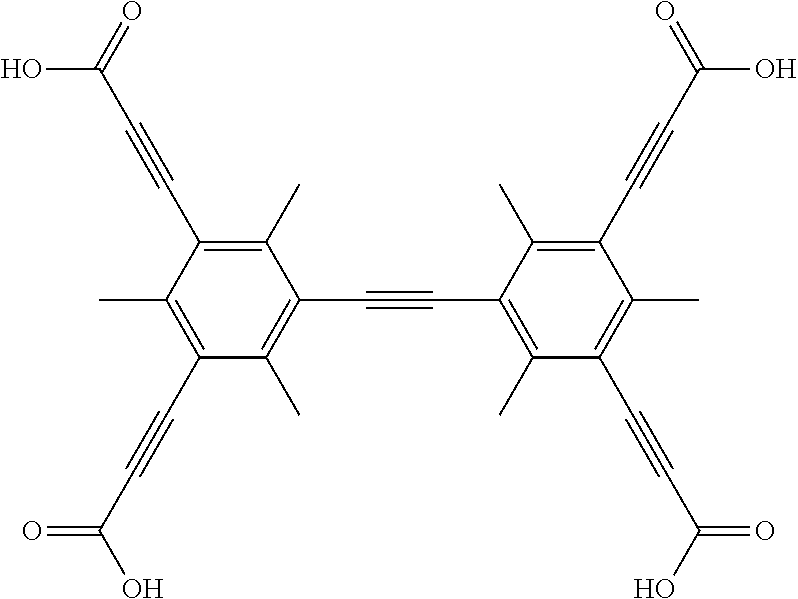
C00014
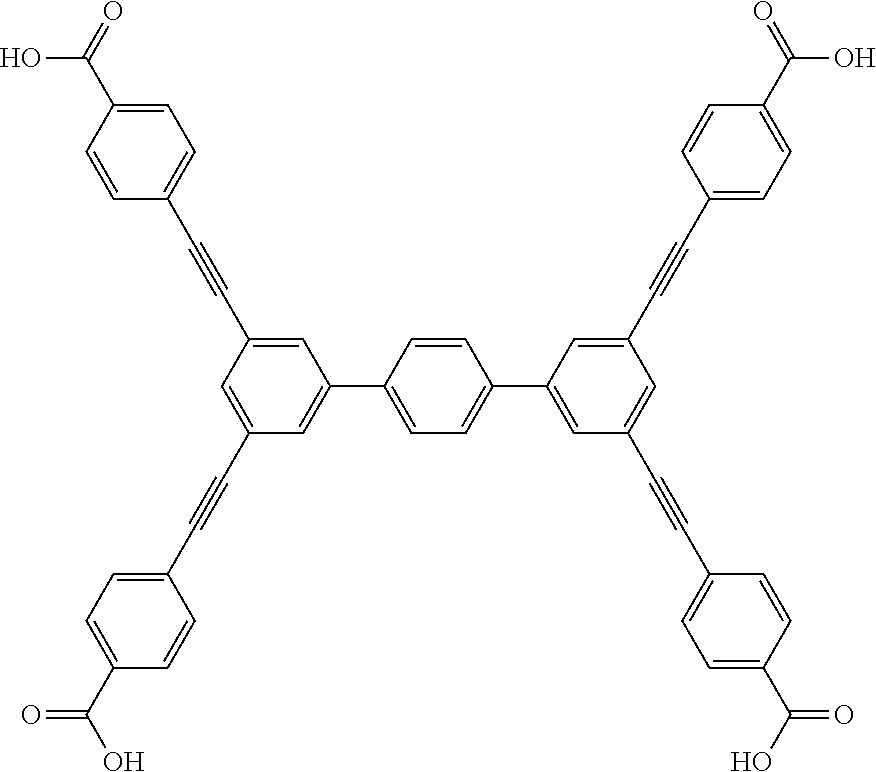
C00015

C00016

C00017
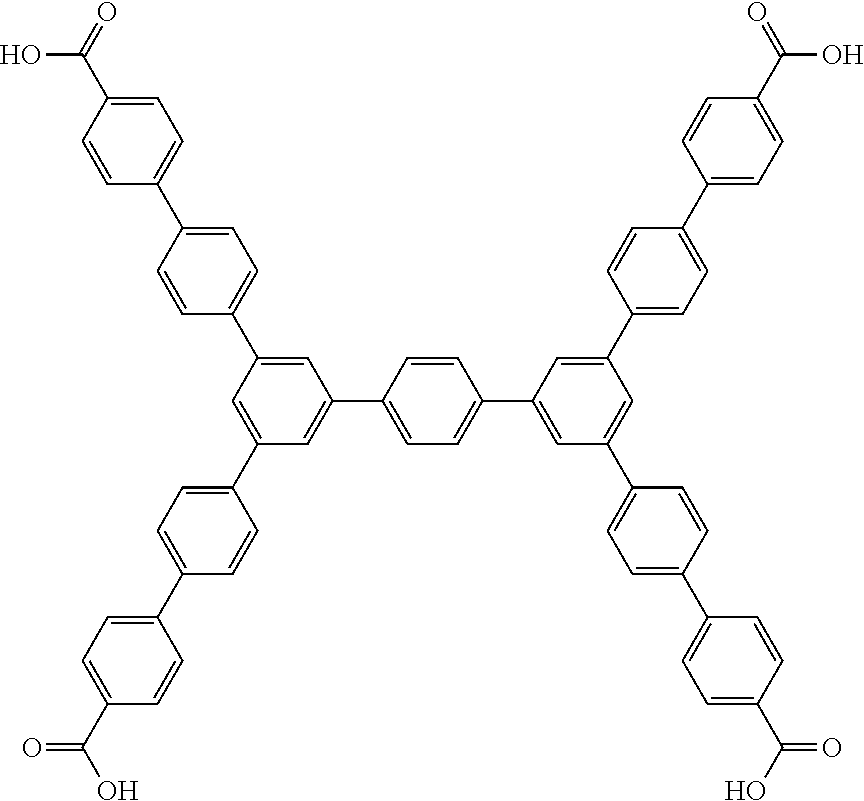
C00018

C00019

C00020

C00021

C00022

C00023

C00024

C00025
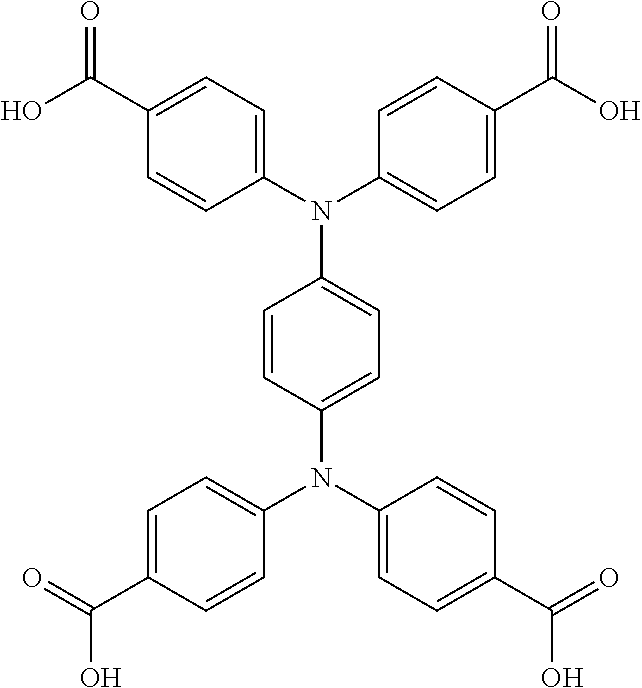
C00026
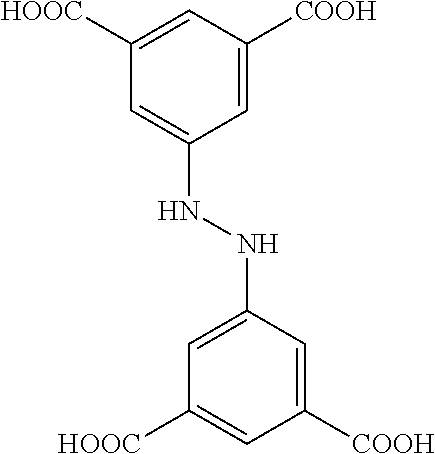
C00027
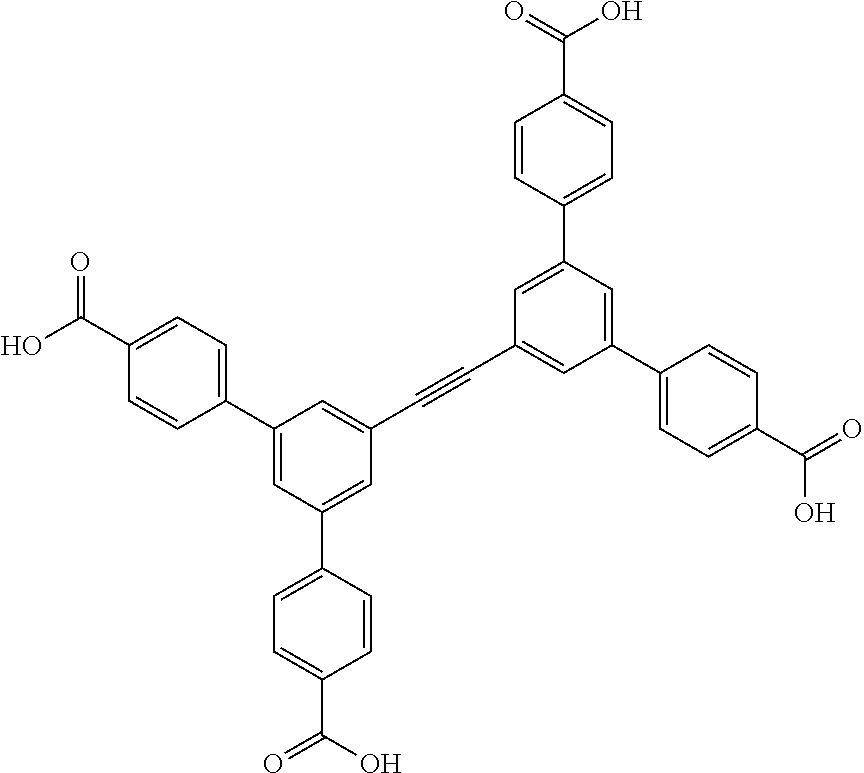
D00000
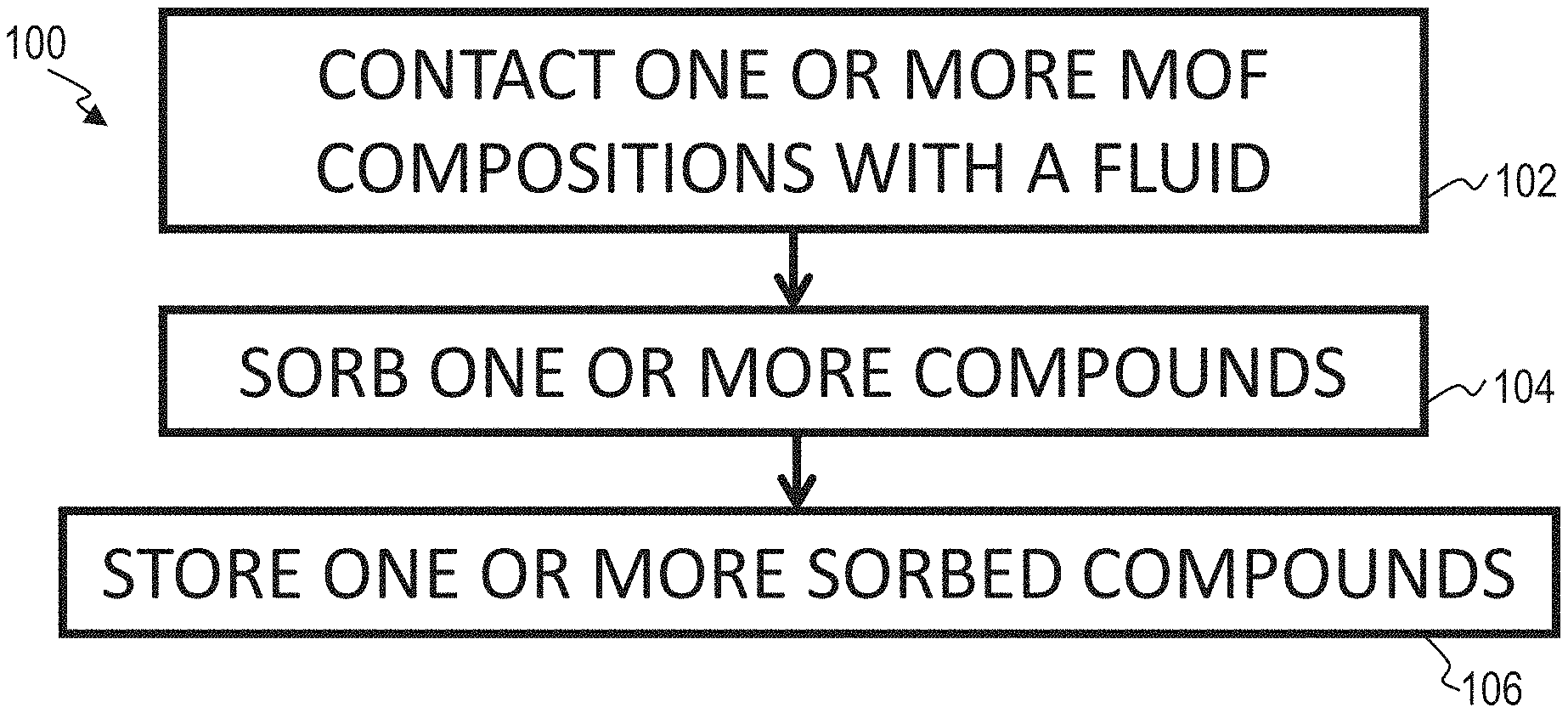
D00001
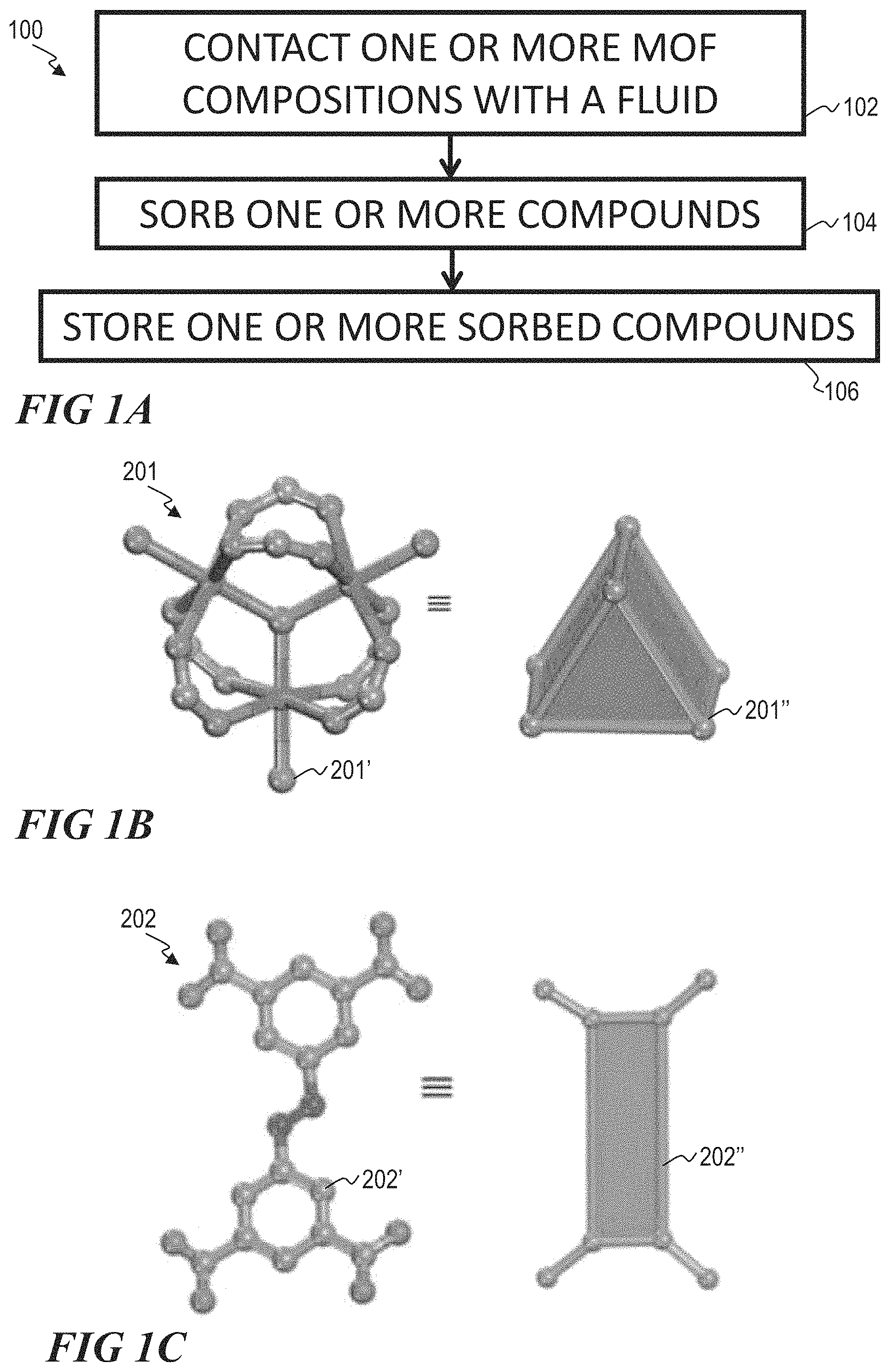
D00002
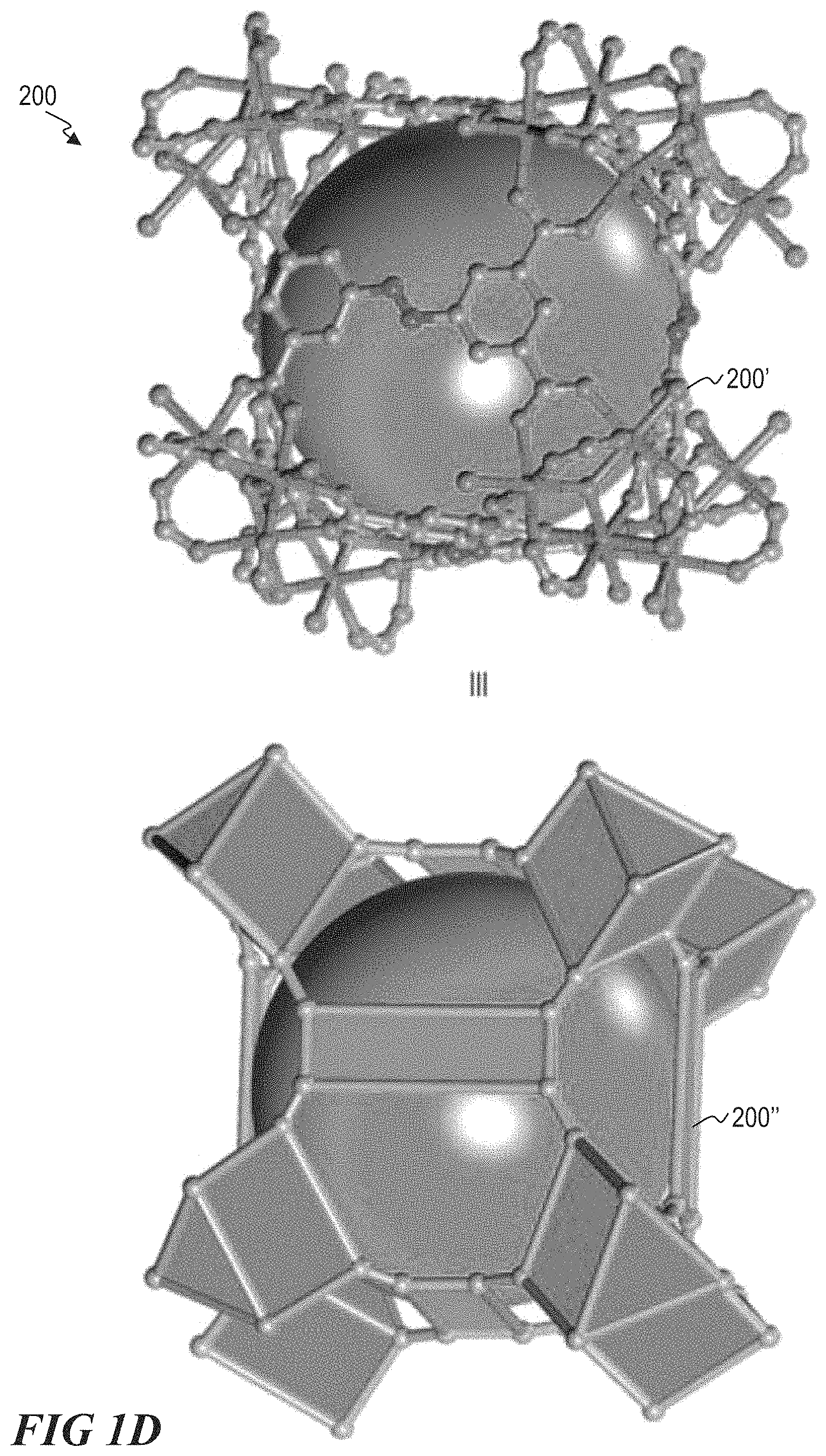
D00003

D00004
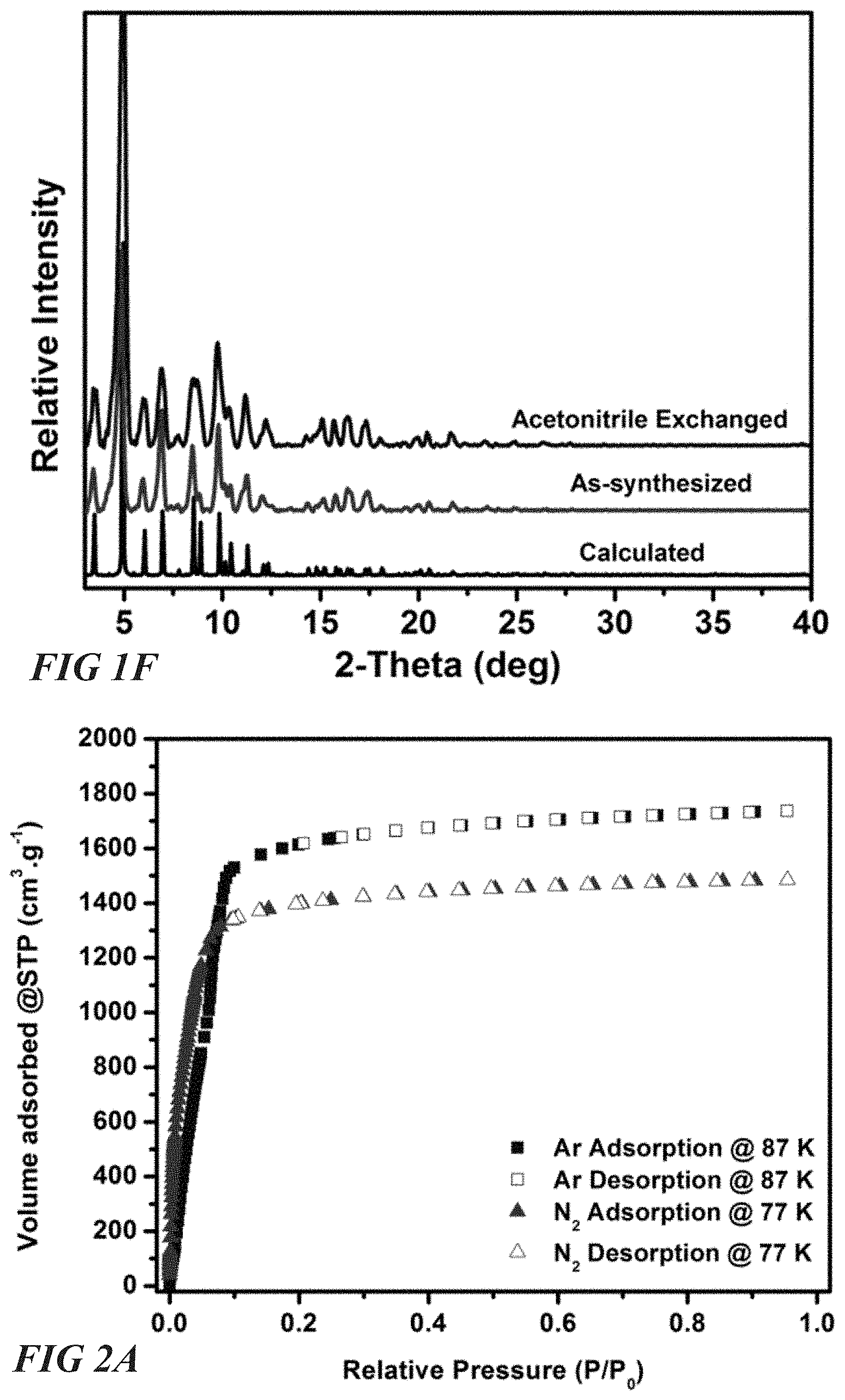
D00005

D00006

D00007
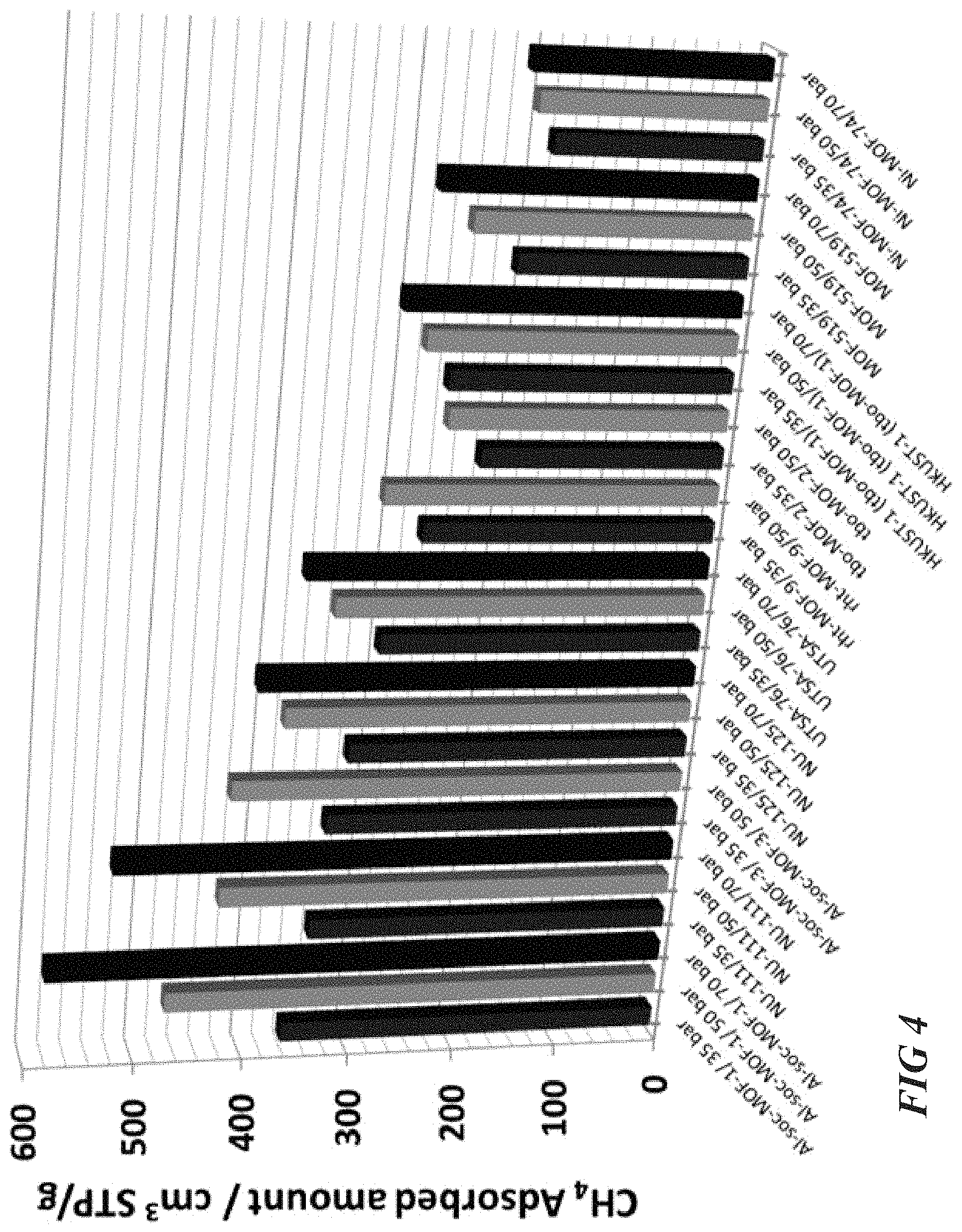
D00008

D00009
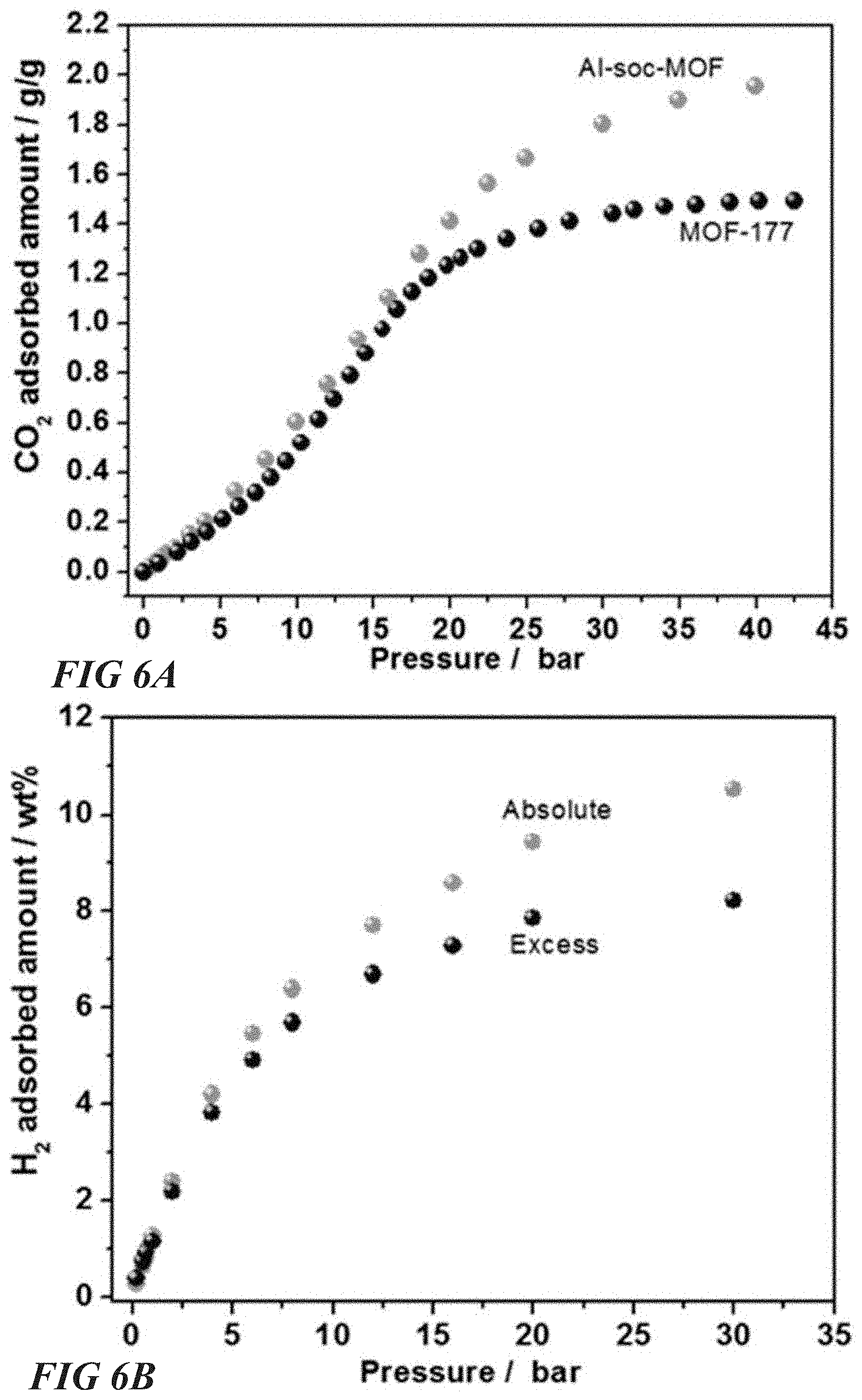
D00010

D00011
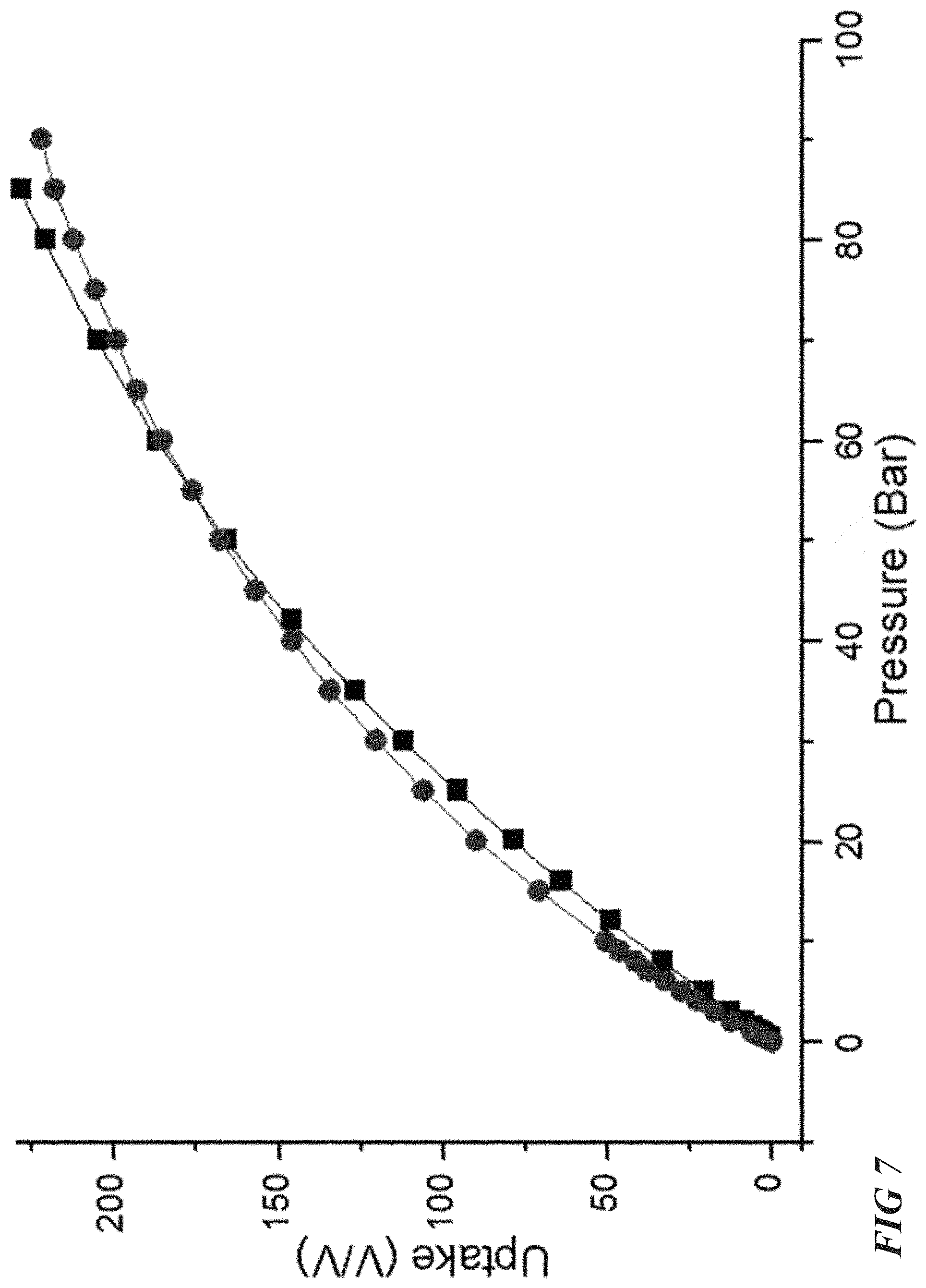
D00012

D00013

D00014

D00015
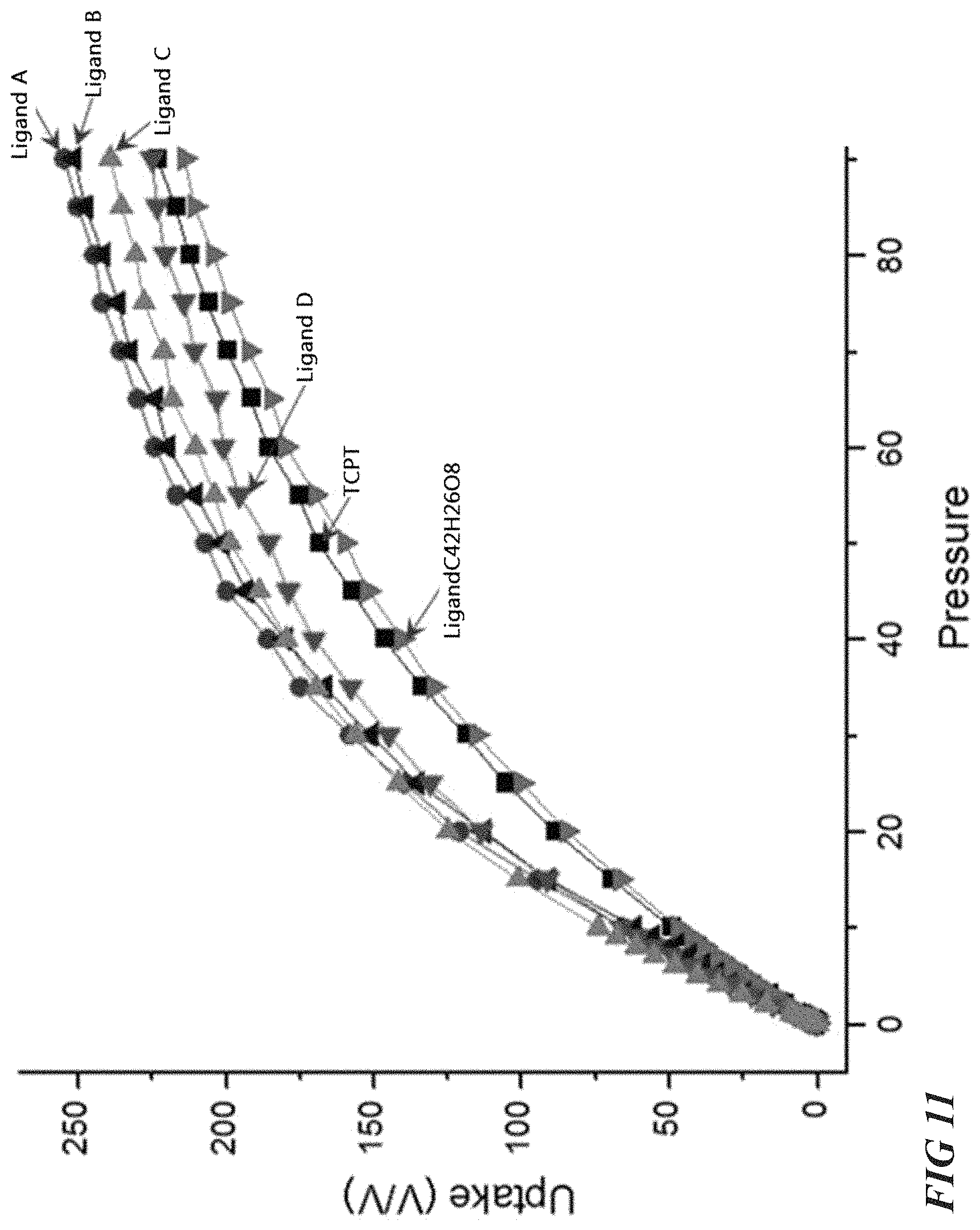
D00016

D00017

XML
uspto.report is an independent third-party trademark research tool that is not affiliated, endorsed, or sponsored by the United States Patent and Trademark Office (USPTO) or any other governmental organization. The information provided by uspto.report is based on publicly available data at the time of writing and is intended for informational purposes only.
While we strive to provide accurate and up-to-date information, we do not guarantee the accuracy, completeness, reliability, or suitability of the information displayed on this site. The use of this site is at your own risk. Any reliance you place on such information is therefore strictly at your own risk.
All official trademark data, including owner information, should be verified by visiting the official USPTO website at www.uspto.gov. This site is not intended to replace professional legal advice and should not be used as a substitute for consulting with a legal professional who is knowledgeable about trademark law.